THE BARKING GECKO
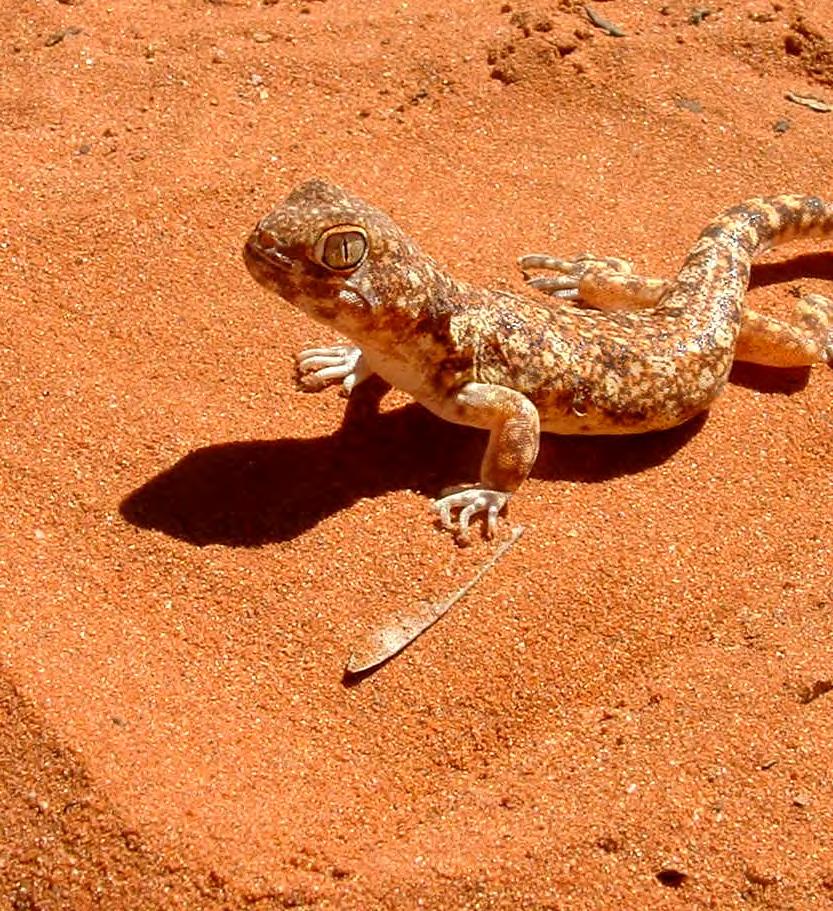
“Heaven is under our feet as well as over our heads.”
- Henry David Thoreau,
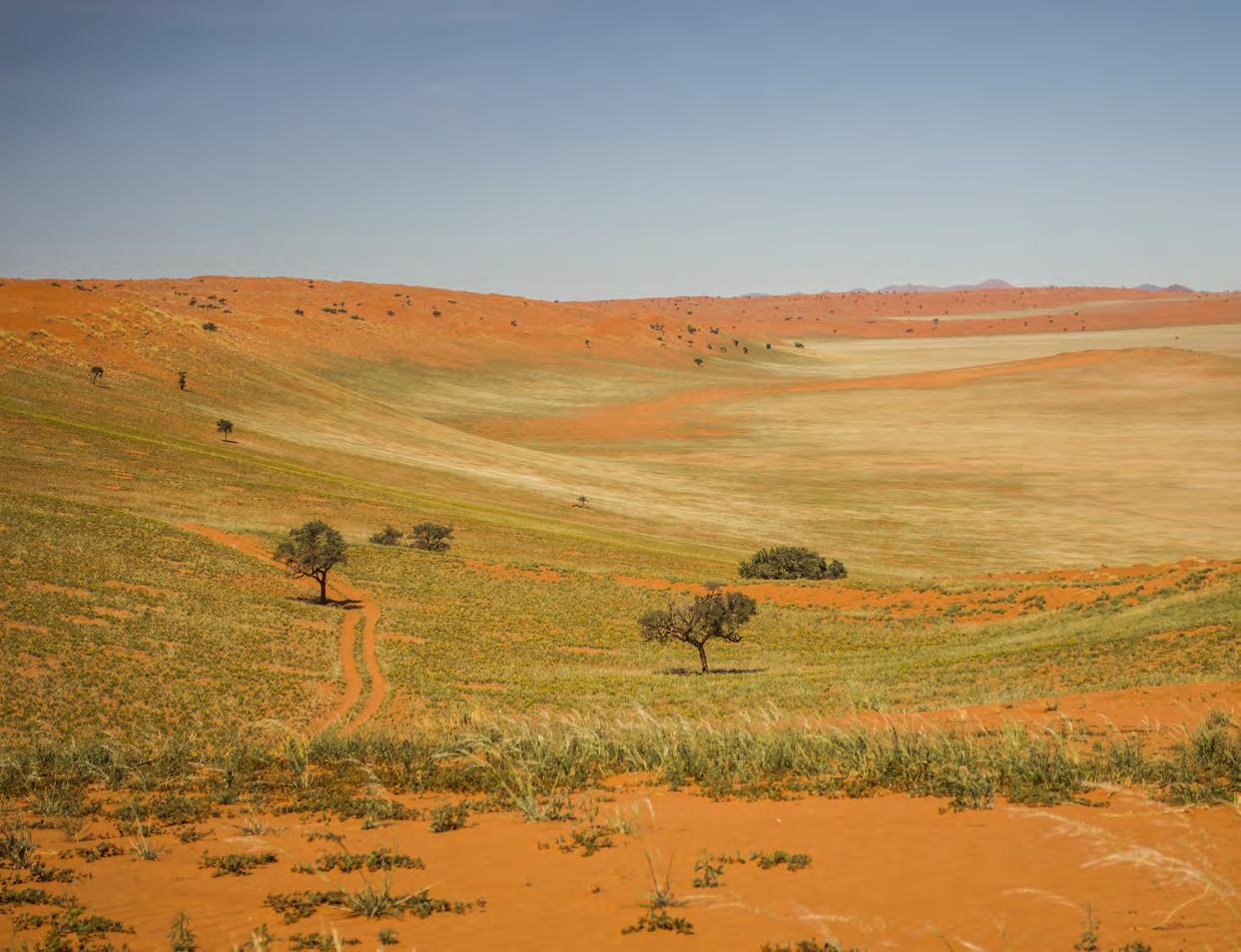


“Heaven is under our feet as well as over our heads.”
- Henry David Thoreau,


Twenty twenty-five arrived and with it, the long-awaited rain we were all longing for. The transformation across NamibRand was immediate: the dry, bare ground quickly transformed to a soft green shimmer and bursts of colour appeared everywhere. It has been an exhilarating time, with many hours spent out in the field recording plant species as they emerged from their dry sleep and flowered.
In January our team hit the ground running, as it always does. In particular, we are happy to celebrate Abraham Tsaobeb’s 30 years of dedicated service this year! We are incredibly grateful to have a team member with such deep knowledge and experience of the area.
The first part of the year has seen some exciting changes on the Reserve. Renovations and improvements have been made, while staff members have travelled to gain new insights and inspiration. At NaDEET, students contributed creatively to the centre, while the Namib Sky Community School implemented some upgrades. Guests visiting NamibRand can once again experience the vibrant landscape on horseback at Wolwedans.
As we look back on the first half of 2025, we are filled with gratitude — for the rain that brought life back to the land, for the students and scientists who enrich our work and for the ongoing opportunities to protect and explore the wonders of NamibRand. Here’s to a year of growth, learning and fulfilled hope.

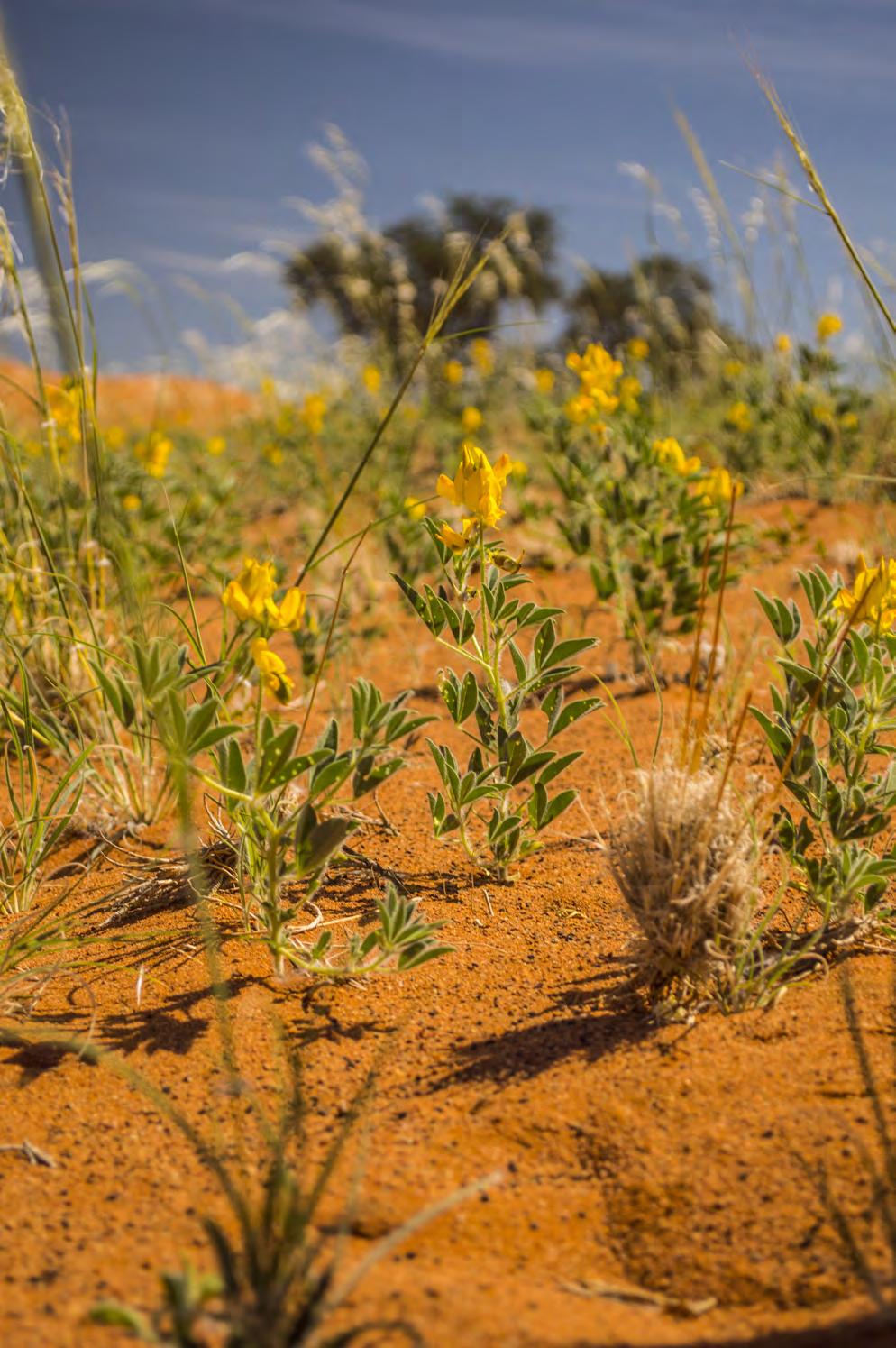
NamibRand had a fantastic rainy season and much of the Reserve received above average annual rainfall after a long drought. The grass is back and the landscape is rejuvenated with life. The overriding theme of this issue of the Barking Gecko is the wonderful rains we received and there are many articles and photos celebrating the season. Wildlife, which can only survive in this arid area by migrating huge distances in search of grazing, is slowly coming back to NamibRand. This is thanks to the work of our staff over the last four decades to remove thousands of kilometres of old, disused livestock fencing in an effort to restore the natural ecosystem, animal migartory routes and landscape connectivity.
Speaking of many decades of work, this year we honour 30 years of service from Abraham Tsaobeb. You can read the article chronicling
his career and experiences with NamibRand. Abraham is a cherished member of the team. His enthusiasm and passion for NamibRand is inspirational and his wisdom has helped guide many managers who have come and gone over the years to navigate the intricacies of running the Reserve. Thank you, Abraham, for your dedication and love for NamibRand over the years. Other staff that celebrate longservice milestones this year are Nils Odendaal (21 years), Ruben Bonifacio (15 years) and Martin Verwey (5 years).
At the end of 2024, we were able to successfully stop mineral prospecting on NamibRand through litigation by filing an urgent interdict with the High Court of Namibia. The court ruled in our favour and we were able to stop the prospector from conducting prospecting on
the Reserve. The situation was complicated. However, it was clear that NamibRand’s rights had been infringed upon due to technicalities with the process of obtaining an Environmental Clearance Certificate and the granting of access for prospecting activities. Once the urgent interdict was issued, the defendants in the case agreed to settle out of court, agreeing to cover NamibRand’s costs in exchange for dismissing the case. It is encouraging to note that the Ministry of Environment, Forestry and Tourism (MEFT) in partnership with the Ministry of Mines and Energy have recently tabled a new policy for prospecting and mining that proposes better safeguards for high value species and protected areas.
At the end of February, we hosted the second International Fairy Circle Symposium on the Reserve
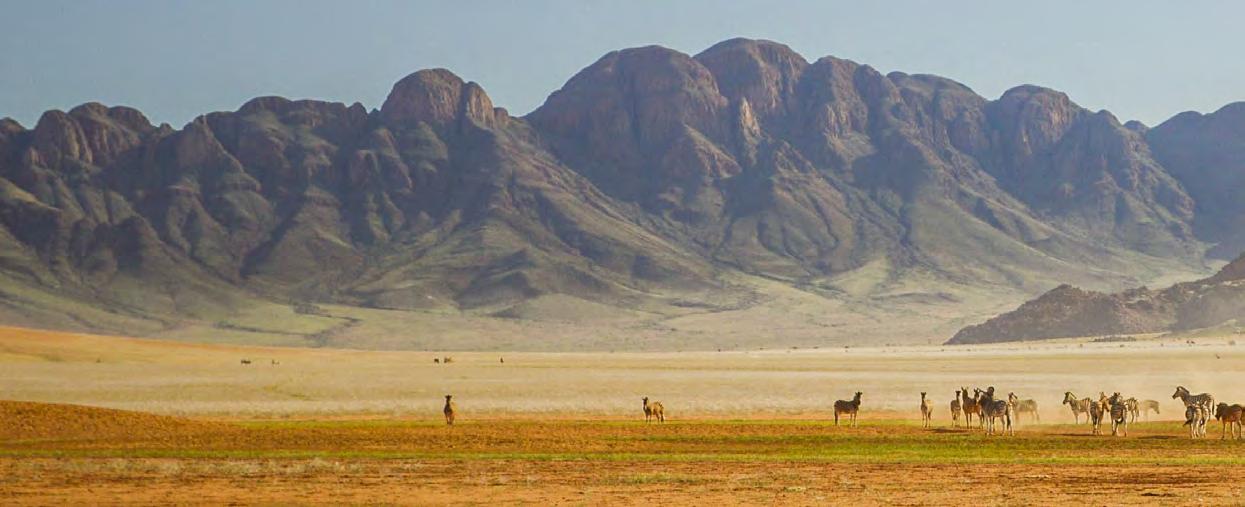
at Wolwedans. This conference took place almost exactly ten years after the first symposium held in February 2015. The article by Eberhard Hofmann outlines some of the leading theories on fairy circles which were presented by scientists at the symposium. While some scientists insist that they have solved the mystery and that they are able to explain the cause and formation of this phenomena, there is still no consensus within the scientific community. Leading theories include vegetation selforganisation, soil poisoning by Euphorbia plants and landscape engineering by termites. Our founder and former CEO Albi Brückner once said, “I find it quite refreshing that in this day and age of modern technology, no one is fully able to explain fairy circles. We don’t need answers for everything in life and it is good that we still have some things that we can’t explain, that remain a mystery.”
The MEFT, in partnership with the Wold Wildlife Fund in Namibia, is finalising the national framework for the registration of Other Effective Area-Based Conservation Measures (OECM) with the International Union for Conservation of Nature (IUCN).
“In 2018, the concept of OECMs was formally defined through the Conservation on Biological Diversity (CBD) Decision 14/8. OECMs are geographically defined areas distinct from traditional Protected Areas (PAs) but managed in ways that yield positive, sustained, and longterm outcomes for biodiversity conservation, including associated ecosystem functions, services, and, when applicable, cultural, spiritual, socio-economic, and other locally significant values. Despite being a relatively recent concept, OECMs offer a promising approach to achieving largescale conservation targets and
mitigating biodiversity loss. (IUCN)” The NamibRand Nature Reserve intends to register as an OECM to gain national and international protection as a conservation area.
To make way for the renovations of the offices of the Namibia Nature Foundation, we have moved our Windhoek office. Come visit us at No. 2 Mozart Street in the old Sushi Tower next to the Wolwedans offices.
I hope you enjoy this bumper edition of the Barking Gecko.
Kind regards,

Nils Odendaal Chief Executive Officer
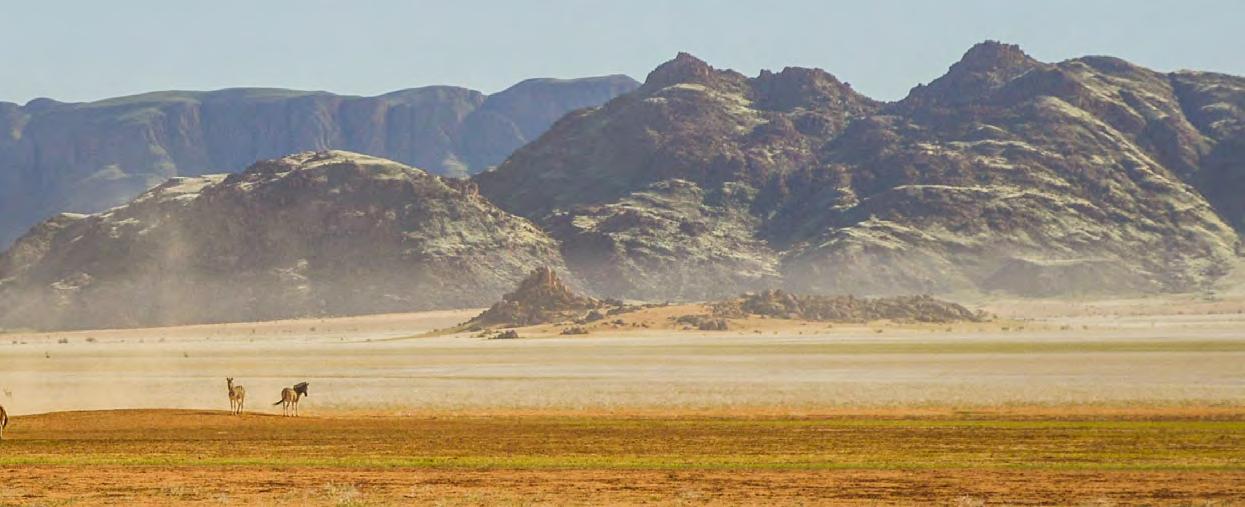
By Annely Ickua
Between January and April 2025, Namibia experienced its most significant rainfall in over half a century, transforming its arid landscapes and bringing both rejuvenation and challenges to the nation. This period was marked by unprecedented weather events, including rivers flowing for the first time in decades, extensive infrastructural damage and as well, a much-needed respite for farmers, particularly in the southern regions.
Namibia, known for its arid climate and low rainfall, typically receives an average annual precipitation of approximately 278 mm, with variations ranging from 650 mm in the northeast to less than 50 mm in the southwest. However, the early months of 2025 defied these norms. In January alone, Windhoek recorded 262.2 mm of rain, surpassing the combined average for January, February and March which stands at 240.1 mm.
This deluge led to the revival of long dormant rivers. Notably, the Swakop River surged, with its waters reaching the Atlantic Ocean at Swakopmund - a phenomenon which occurs only once every several years. Similarly, the Kunene River along Namibia’s northern border recorded a flow of
320.40 cubic meters per second on 20 March 2025.
The southern regions, often plagued by drought, experienced a dramatic transformation. The Neckartal Dam, the largest in Namibia, began overflowing on April 7, 2025, a testament to the volume of rainfall received. Similarly, the Naute Dam reached 107.3% capacity, prompting controlled water releases to manage the surplus. On the NamibRand Nature Reserve, home to the Wolwedans Collection, the typically arid landscape blossomed. The area, which usually receives an annual mean rainfall of 70–80mm , recorded 22 mm in a single day. This is a significant event for the region. The rains revived the desert, bringing a rare and beautiful softness to the terrain.
For farmers, especially in the south, the rains were both a blessing and a challenge. After years of drought, the precipitation revitalized grasslands and replenished water sources, offering hope for improved agricultural yields. However, the sudden and intense rainfall also posed difficulties. Livestock farmers faced challenges such as waterlogged grazing areas and increased disease risk among animals.
In the northern regions, the
situation was more dire. At least 16 people lost their lives in the Oshana Region due to flooding, with thousands displaced from their homes. The floods also led to the postponement of activities such as the Fish River Canyon hiking trail, highlighting the widespread impact of the rains.
The extraordinary weather patterns observed in early 2025 have highlighted concerns about the influence of climate change on Namibia. The Namibia Meteorological Service has noted an increase in extreme weather events, including higher temperatures and more unpredictable rainfall patterns. The recent rains, while beneficial in some respects, also underscore the volatility of a changing climate.
The La Niña phenomenon has been identified as a contributing factor to the heavy rains, with experts noting that Namibia experienced its highest recorded rainfall in five decades due to this climatic event. However, the interplay between natural climatic variations and humaninduced climate change complicates the predictability and management of such events.
Visit www.wolwedans.com and experience the land of the brave within the NamibRand Nature Reserve.
22 mm downpour at Wolwedans on 7 March
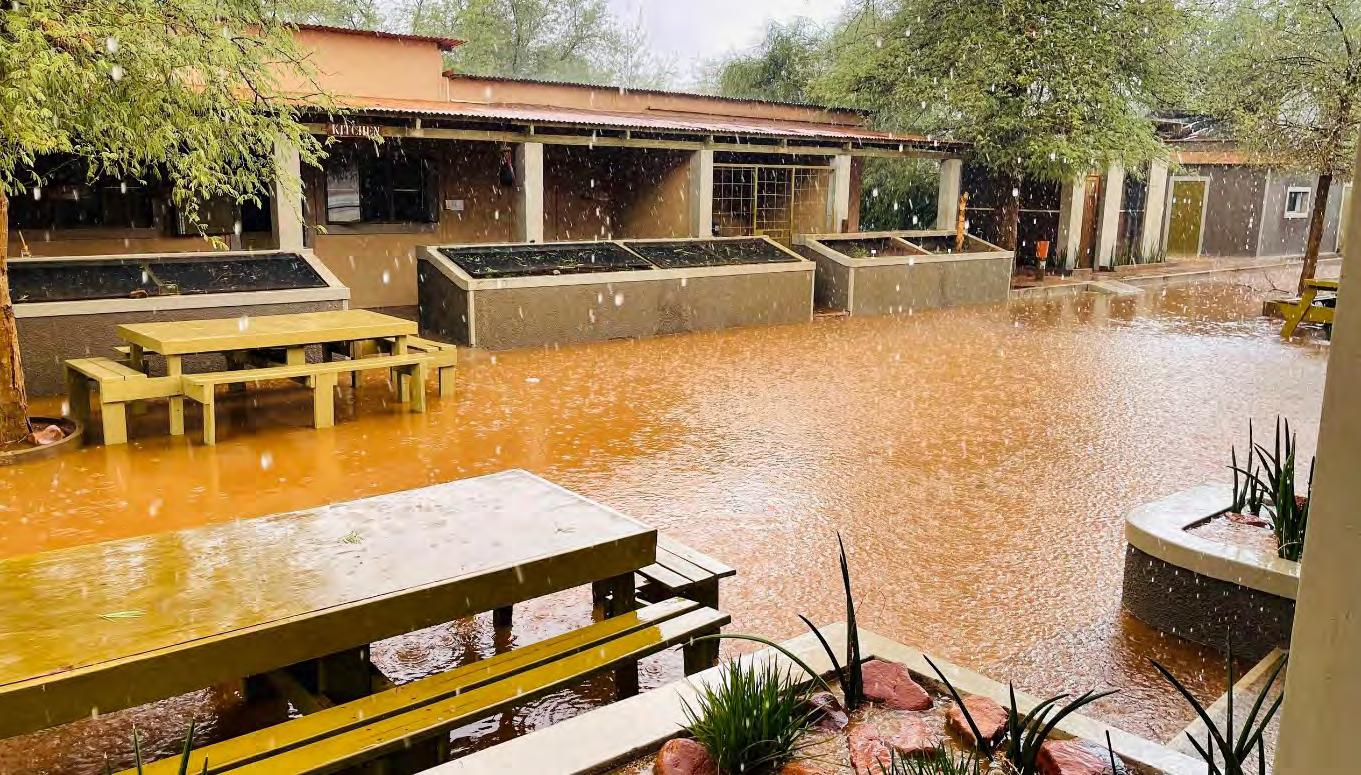
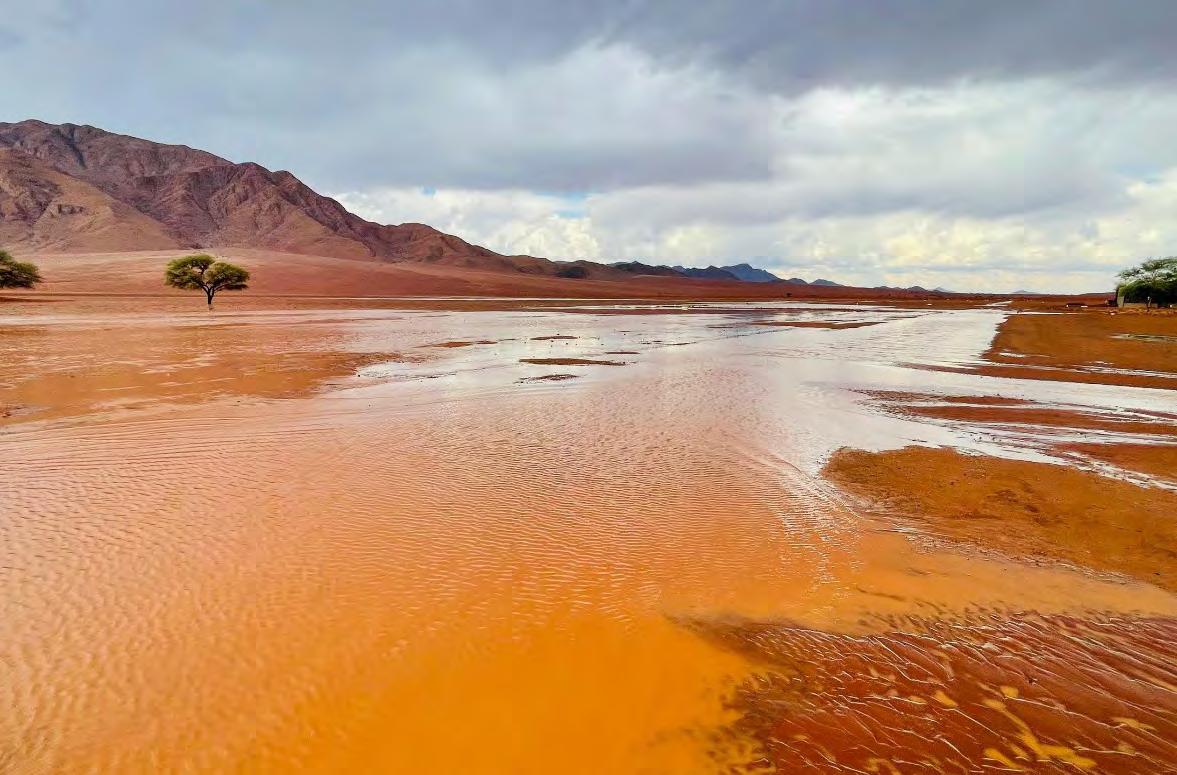
By Jessica Steyn
The start of a new year always brings fresh hope, and 2025 certainly delivered with the rain we so desperately needed. After years of waiting and hoping, we were blessed with enough rainfall to transform the landscape. The earth responded with a vibrant burst of life: plants bloomed, grasses grew thick and green, and wildlife returned in numbers, migrating from neighbouring farms and the national park to enjoy the bounty.
Repairs and Upgrades
Although the rain was good, the start of 2025 wasn’t without its challenges. At Keerweder, we experienced several issues with the generator and electricity supply, but true to our spirit, we adapted and found solutions.
The strong winds at Keerweder took a toll on the office veranda’s shade netting, which was constantly tearing. It became clear we needed a
more permanent solution. New poles were planted, and a sturdier structure was created. The result is a shaded veranda that will withstand the elements much better, providing respite from the sun for years to come.
Welcoming Scientists and film makers
On 1 and 2 January, we had the pleasure of hosting Professor Hezi Yizhaq from the Department of Energy and Environmental Physics at Ben Gurion University in Israel. He came to study the fairy circles along road tracks, measuring their dimensions and observing sand ripple formations. It’s always inspiring to collaborate with experts who are so passionate about the wonders of our landscape.
The 2nd International Fairy Circle Symposium took place on 27 and 28 February. Kindly hosted by the Wolwedans Collection, the Symposium brought together researchers who shared their latest findings on fairy circles with each other

and Reserve staff and guests. After a day of presentations, everyone enjoyed a sundowner at Chateau Viewpoint and dinner at Wolwedans Dunes Lodge. The next day was spent in the field, offering a hands-on look at the fascinating research being conducted. Several researchers stayed on at Keerweder from 1–2 March, investigating soil structure and plant material at sites around the Keerweder Pan and Jagkop.
In March and April, we welcomed John Irish, an entomologist conducting an insect diversity study for NamibRand. His research is part of a broader insect study for NamibRand, promising fascinating insights into the small invertebrates that thrive here. John was joined by the film maker, Bon Bonné de Bod, who filmed on the Reserve. The production will be part of the television series ‘Bewonder and Bewaar’ (Nature’s Wonder and Conservation). It is a television series that unlocks the mysteries of Mother Nature as seen through the eyes of dedicated wildlife researchers, vets and conservation scientists. It is a South African production for DSTV on the KykNet channel.
Students Gaining Hands-On Experience
Education and mentorship are core to our mission. In January, a student from Wolwedans joined us for a week to gain handson conservation experience, assisting with pipelines, fencing and general reserve maintenance. Later that month, we welcomed three natural resource management students from the Namibian University of Science and Technology (NUST) for their Work Integrated Learning internships. They joined the team until the end of
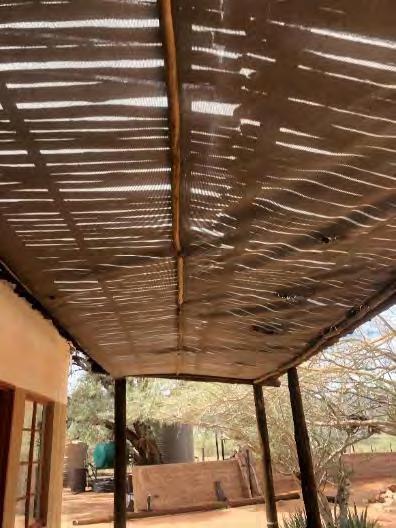
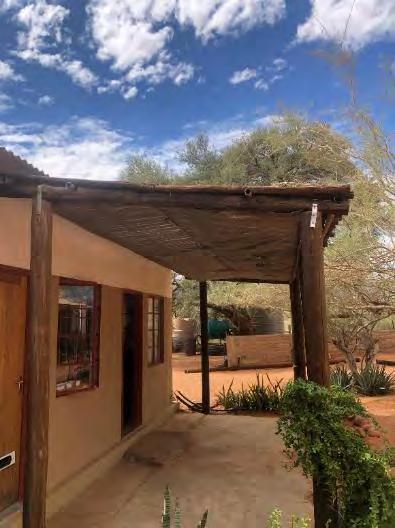
May, gaining valuable skills and helping us manage the Reserve.
The Wonders of Rain Rain not only brought a fresh green landscape to life, but also awakened a hidden world. Along the foothills in the north, the grasses flourished, drawing large herds of wildlife. In addition, an explosion of insect life took place. Butterflies and moths fluttered everywhere, and our staff was busy photographing and identifying as many species as possible. Among the more special sightings was the red velvet mite (Trombidiidae), fondly known in Namibia as the rain bug or rain baby. These bright red arachnids live hidden underground for most of the year, only emerging after good rains. Though they look similar to spiders, they are harmless predators that feast on insect larvae and eggs.
That’s not all. In the rain-filled borrow pits and puddles, we witnessed the appearance of ancient creatures: Triops, also known as tadpole shrimps. These
tiny crustaceans are true living fossils, having been present on earth for over 250 million years. Spending most of their lives as dormant eggs, Triops hatch when the rains come, feeding, mating, and ensuring their next generation will be ready for the next rain event.
On 21 March, Jessica and Andre went for a hike at the foot of the Nubib Mountains. Their exploration led to the discovery of a new spring, complete with a magnificent sycamore fig (Ficus sycomorus). They also documented and collected various plant species unique to the foot slope area, further enriching our knowledge of the Reserve’s botanical diversity.
The annual Dark Sky Report for NamibRand was updated and submitted to the International Dark Sky Places (IDSP). You can access the final report here. Our commitment to protecting the night sky remains as strong as ever.

Bird Count
On the weekend of 8 and 9 February, Jessica and Andre participated in the summer bird count at the coast, surveying seabirds at the Walvis Bay Lagoon and Saltworks. It’s always rewarding to contribute to broader conservation efforts beyond the Reserve.
Citizen Interaction
In May, Jessica gave a presentation at the Namibia
Scientific Society in Windhoek. The talk focused on our Quiet Park accreditation - explaining how it works and how it ties into our broader conservation goals. This was a valuable opportunity to engage with Namibians and share the important work we are doing across the country.
Additionally, various meetings were held with visiting guests at the lodges, including representatives from other
organisations. These interactions offered valuable insight into how we manage and operate the NamibRand Nature Reserve, showcasing our approach to conservation, tourism and sustainable land use.
Exchange of Work Experience
A meaningful partnership was revived between Gondwana and NamibRand. In May, Michelle Rodgers, Warden of Gondwana Canyon Park, joined the Keerweder team for the annual game count. She extended her stay for a few days, allowing for a valuable exchange of knowledge and experience, particularly around flora and fauna.
In June, Jessica and André travelled to Gondwana Canyon Park, where they participated in their game count and spent a few days exploring and learning about the area. The exchange was mutually enriching and everyone thoroughly enjoyed the experience.
Future reciprocal visits are planned, continuing this valuable collaboration and fostering stronger ties between the two conservation areas.
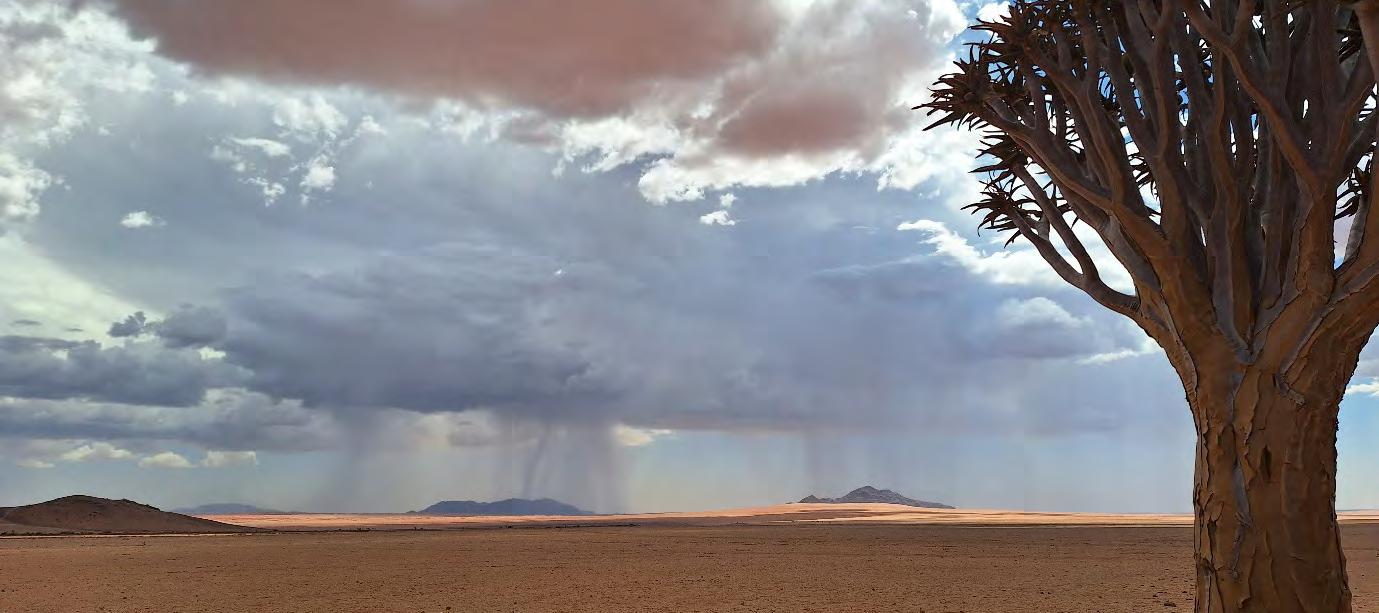
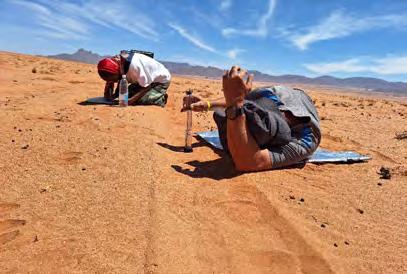
Measuring the water infiltration rate on vehicle tracks
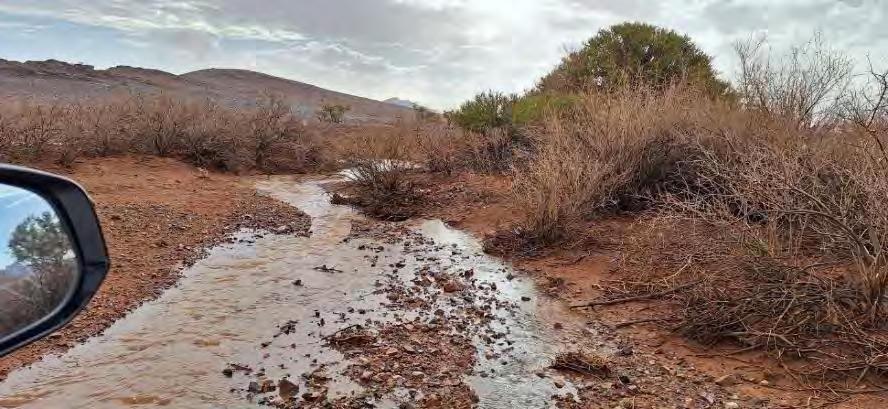
A small river in flood close to Keerweder
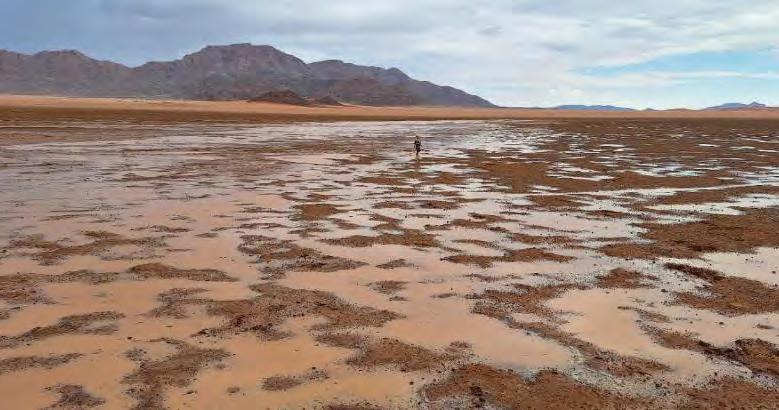

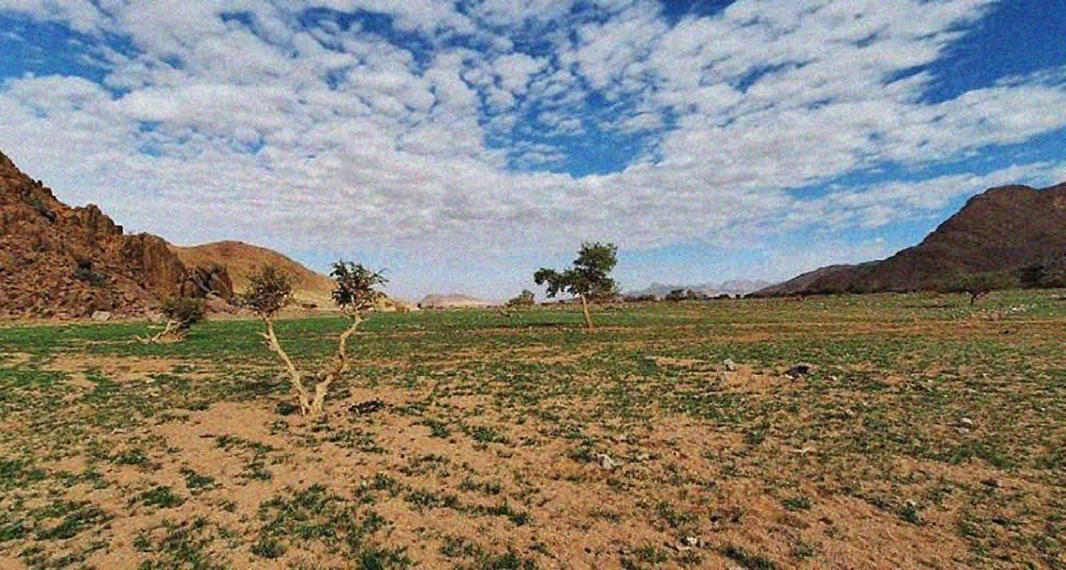
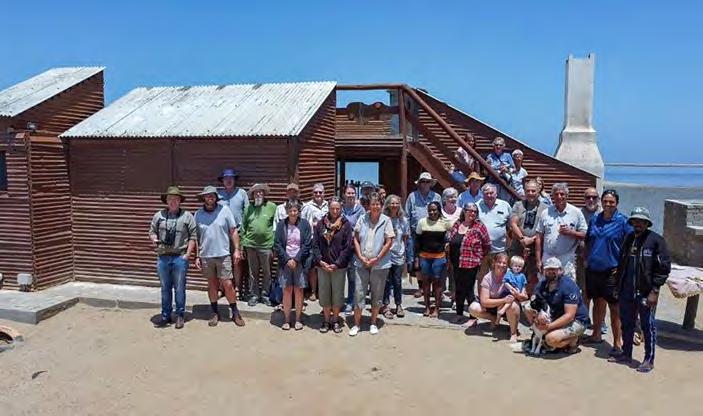
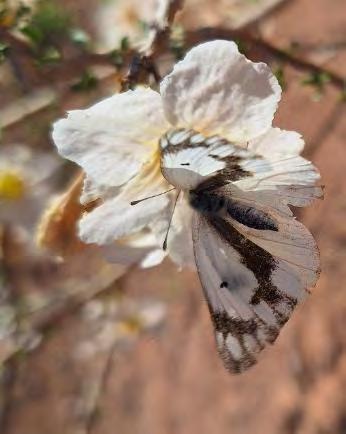
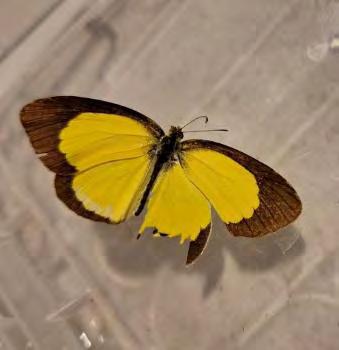

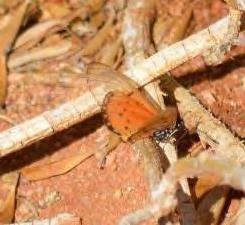



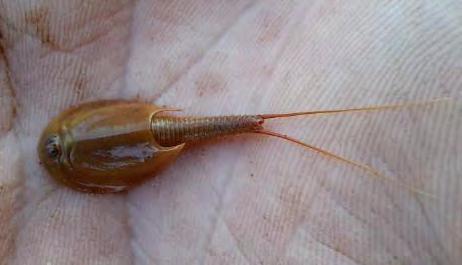
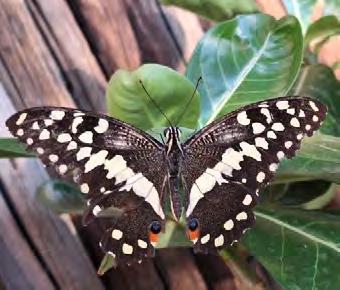


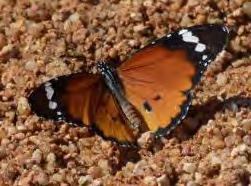


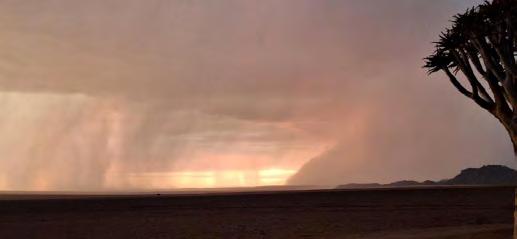
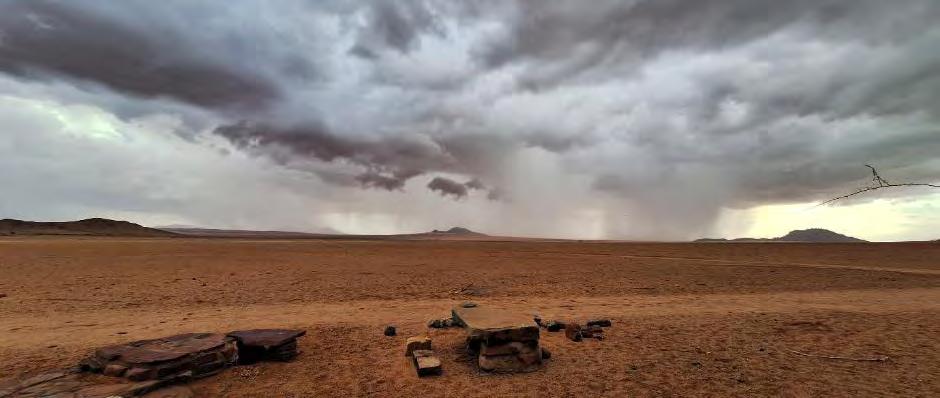

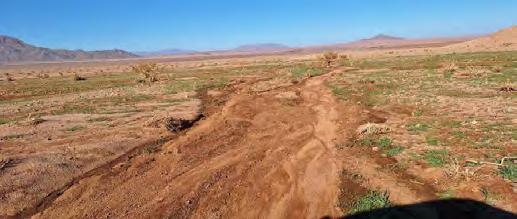
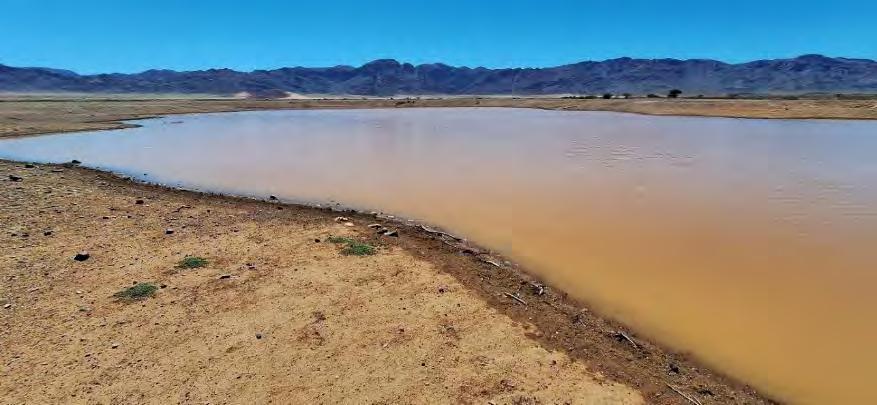

area
with the grass starting to show inflorescence


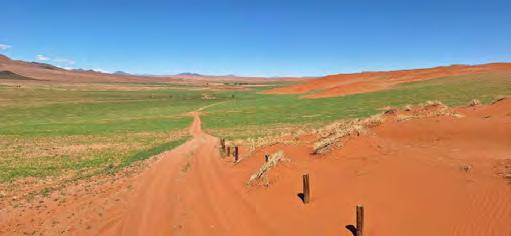

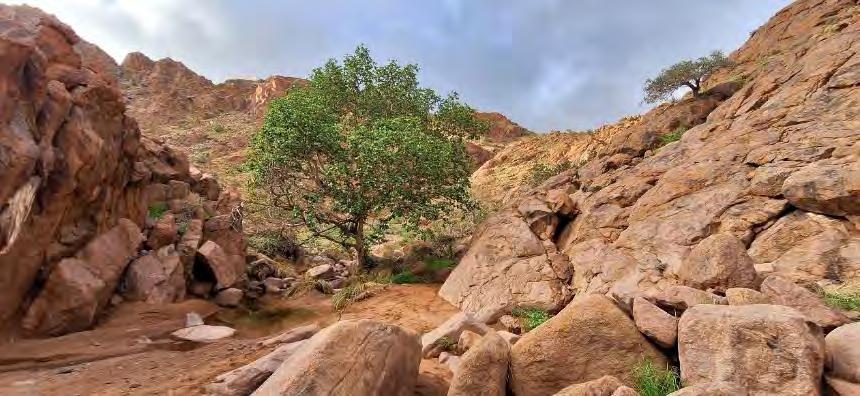

By Martin Verwey
Here on the southern side of the Reserve, 2025 started rather sandy and dry. There was no sign of rain yet, but we remained positive that it would come this year. There had been rain showers all around us, so we knew it was only a matter of time before it was our turn to be blessed.
Amidst the wind that drives the dust across the bare desert plains, we continued with our normal work routine despite the lack of rain. We graded roads, checked and cleaned waterholes, and repaired fences that were damage by oryx desperate to migrate to areas in the east where there had already been some rainfall. Sometimes we retrieved oryx tangled in fences because they were too weak to
get through. This was the first year that we noticed that the zebras were starting to get thin due to a lack of grazing.
Early in the year we constructed new fences for some of the water camps and removed the vulture hide tanks that are no longer in use. In addition, the NamibRand team, together with the new students, worked on the border fence between Wolwedans and Wêreldend until the sun and dusty winds became too unbearable. For a while we even had to postpone the work until the weather conditions eventually improved.
In March, after being away from the Reserve for two weeks of leave, we received a phone call with news of the first 28 mm of
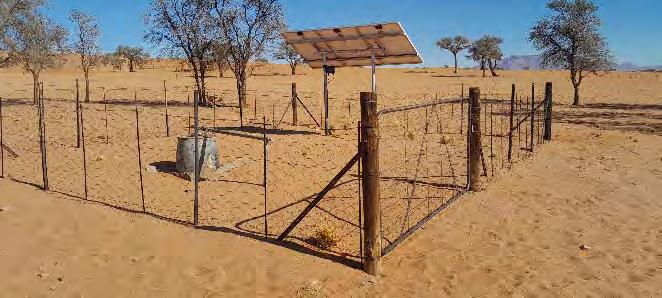
rainfall at Aandstêr. This was the start of our rainy season in the South. One can only imagine how happy and excited the scent of wet soil and rain makes wildlife and humans alike. You can see the dry plains changing into the most beautiful green shades, covered with a fresh new blanket. Before our eyes, the red sand turned into green fields, and we spotted happy springbok lambs, zebra foals and oryx calves. It is no wonder they say that, “Most farmers’ problems are solved with rainwater.” By the end of March the South also received a good amount of rain as can be seen in the rain table on page 17.
With the rain, the most beautiful, delicate wildflowers and spiders came out - even the rare red velvet mite. When one drove in the veld and walked around the house, everything was alive again. You even saw the honeybees at work, excited about the flowers supplying them with enough food again.
This is the beauty of the Namib Desert. It never disappoints. It remains a wonderful place to stay. It is beautiful when it is dry and the sand is red, and it is even more beautiful when it has rained, and the veld turns green. Blankets of grass look like they
are dancing in the wind and the birds are chirping and enjoying the grass. Life is renewed and good in the desert again, at last.
During the Easter weekend, we were fortunate to spot a beautiful leopard near Strausenwasser with her cubs. The cubs disappeared into the tall grass before any photos could be taken of them, but the mother stayed a little behind so we could take some pictures.
I would not trade life in the Namib Desert for a life in a concrete jungle. Until next time, I remain content with the red sand still in my shoes.
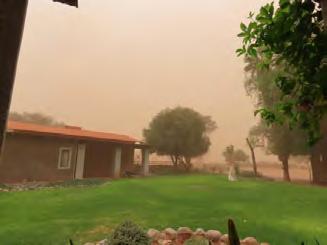
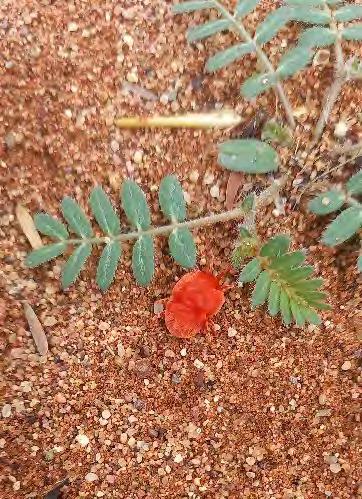





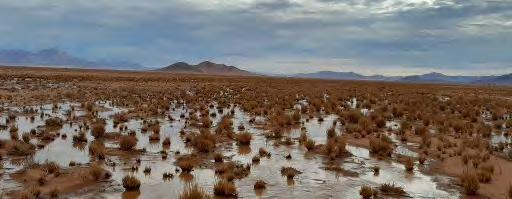
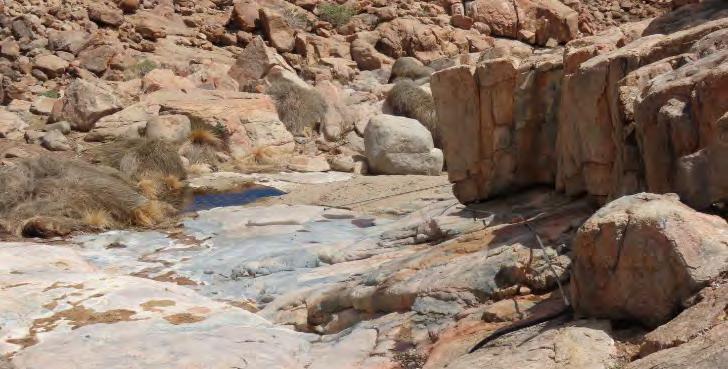


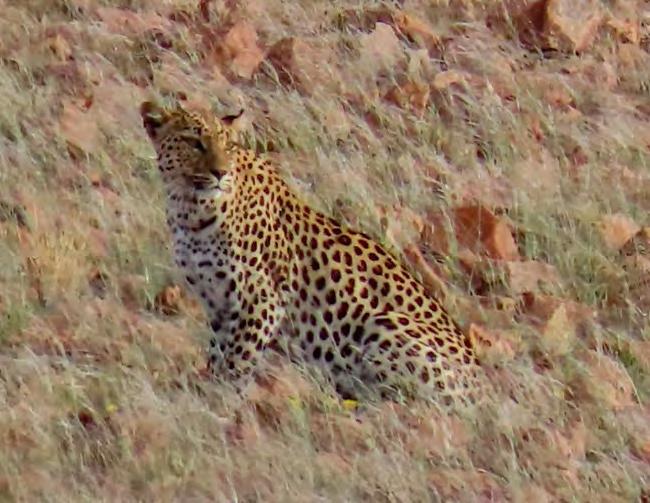


Group
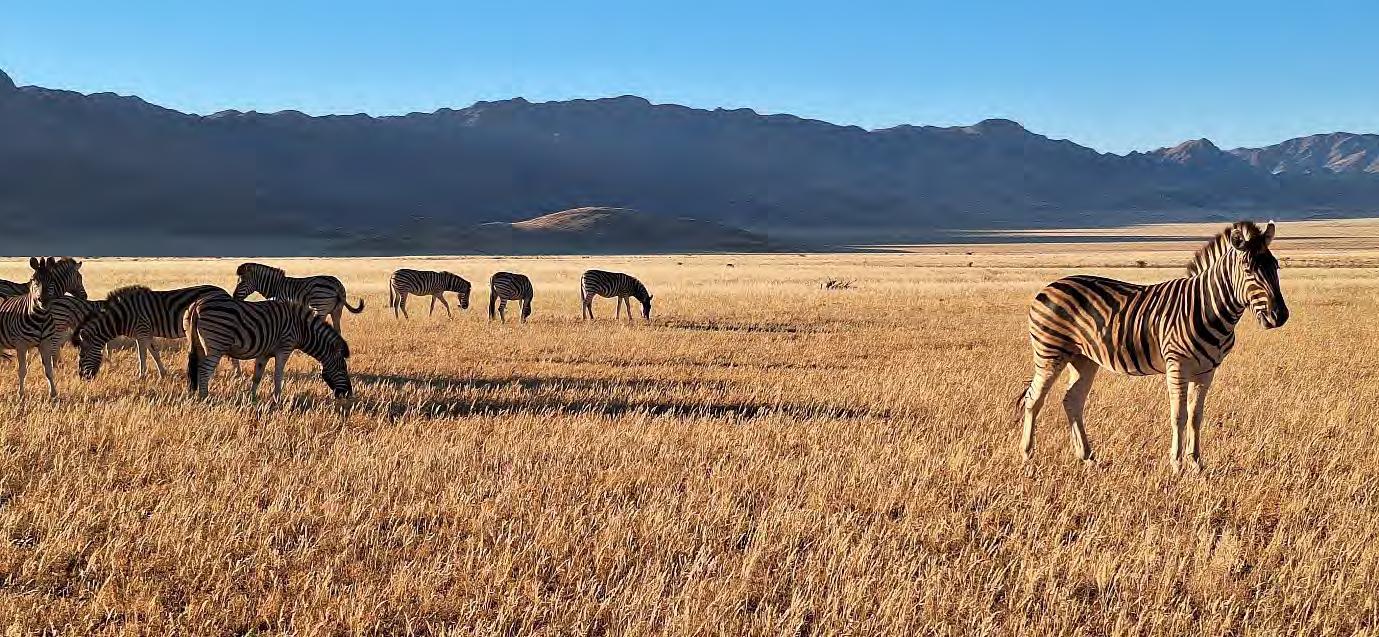
By Jessica Steyn
In the days leading up to the annual game count, all participants were briefed on procedures. Warden Jessica Steyn visited several concessionaires and engaged with participants directly to explain the count methodology, as well as to allocate teams for the various game count routes.
NamibRand Nature Reserve has a long-term average annual rainfall of 70 mm. This year, the Reserve received an average of 56.76 mm, significantly higher than the previous year’s average of just 4.3 mm. This notable increase in rainfall led to a marked improvement in vegetation, which, in turn, attracted wildlife back onto the Reserve. In contrast, many animals had migrated elsewhere in search of better grazing conditions in 2024.
The number of animals recorded per route ranged from 19 to 348 individuals, including
bird sightings, contributing to a total of 1,890 animals observed. The actual wildlife counted in May 2025 totalled 668 oryx and 684 springbok. This marks a notable increase from May 2024, when 557 oryx and 119 springbok were counted. Burchell’s zebra numbers also rose from 273 in May 2024 to 369 in May 2025.
In 2024, most animals moved southward in response to better rainfall in that area. This year, distribution was more balanced across the Reserve, though the northern areas still had higher concentrations of wildlife. Oryx were predominantly found in the dune areas, while springbok and Burchell’s zebra were found on the open plains.
It is important to note that this method is best suited for monitoring large plains species such as oryx, springbok and Burchell’s zebra. It is less effective
for detecting smaller species like steenbok or animals with more specific habitat preferences, such as kudu or mountain zebra. Carnivores are generally monitored using alternative methods, including camera traps and the mark-and-recapture technique.
Population figures derived from the count are estimates rather than definitive totals. Wildlife management at NamibRand is guided not by population estimates alone, but by trends in animal numbers and distribution patterns. This specifically means that we focus on whether populations are increasing or decreasing, and where animals are concentrated across the landscape. These insights are drawn directly from observed sightings and not from estimated totals. The total difference in the overall population estimate has increased between 2024 and 2025 by 78%.
Species
* Total (estimate) numbers known

The game count area with the ten routes
For the game count report, wildlife distribution is based on the number of animals seen in each grid square or monad.
During the game count, each sighting is marked in the corresponding grid square or monad. This data is then used to map the distribution of the animals (i.e., where animals were seen).
Please note that all the game species counted (actual numbers) were used in the calculation (mapping) for the total wildlife distribution. The maps below show the total wildlife species distribution and density distribution.
Please note that the data is indicated on a gradient from light (low values) to dark (high values).
The rain values were added to the maps to indicate where and how much rain was recorded; the bigger the circle, the more rain occurred there.


The long-term total population estimates for oryx, springbok and Burchell’s zebra are presented below for all zones. It shows the long-term actual population and total population estimate change compared to the average annual rainfall received for the same period. Please note that the data for this graph was taken from the total population estimates and the maximum number of routes counted in each year.
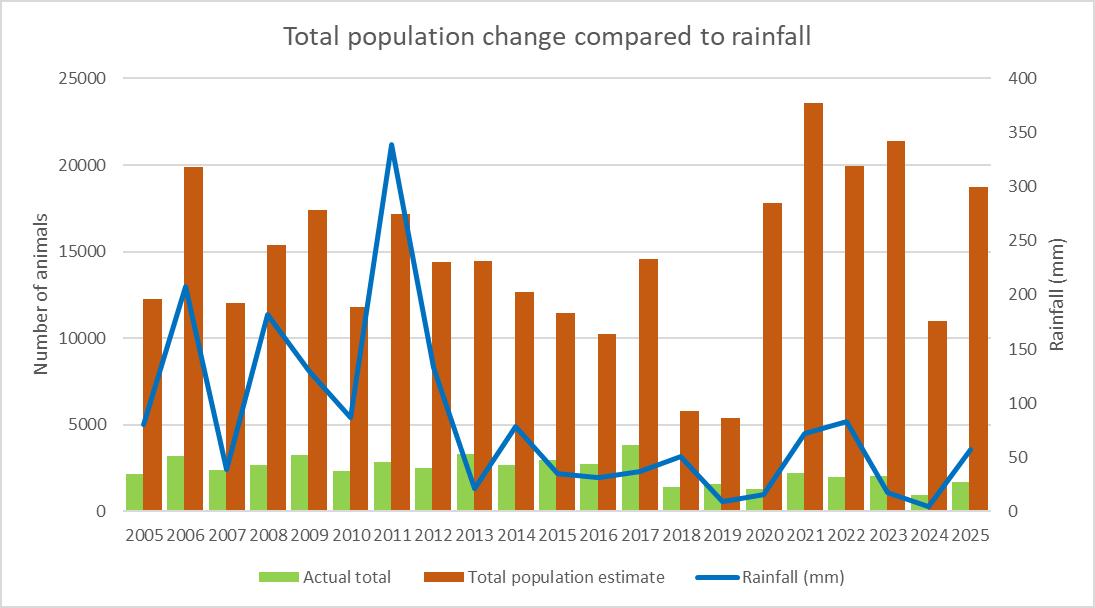
Total population change from 2005 to 2025 compared to average rainfall for oryx, springbok and Burchell’s zebra
Compiled by Jessica Steyn

For over 60 years, Abraham Tsaobeb’s life has been interwoven with the shifting sands and silent rocks of the Namib Desert. Over the last 30 years he has been a steadfast guardian of the NamibRand Nature Reserve. Abraham’s story is one of deep-rooted dedication, quiet resilience and a remarkable memory for this land in the Namib that he has called home.
Born on Farm Sukses, now a ranger station in the NamibNaukluft National Park, Abraham’s early years were spent under the vast skies of the desert. During his later childhood, he lived in Rehoboth for 15 years before returning to the familiar dunes and plains of the area.
His return to the desert marked the beginning of a long and varied career. At Farm Witwaters,
now known as Little Sossus, he started working as a plaaswerker (farmworker). This work led him to Farm Geluk, where he briefly joined the world of horse racing to care for and train horses, even assisting with the operation in South Africa for a year before settling into a more stable role at Farm La Motte where he stayed for four years.
Abraham then moved to Farm Toskaan and worked there for seven years, which eventually became part of the NamibRand Nature Reserve. Abraham’s connection to this land was not
only professional but deeply personal. He often shares vivid memories of the garden that once flourished at Toskaan and the many fruit trees that grew there. Remnants of that time, including a section of fence formed by trees, still stand as a silent witness to history. Sadly, a severe drought claimed much of what once thrived there.
Abraham’s path then led him to Farm Wolwedans, where he started working for NamibRand under its first warden, Marc Paxton, and lived at the Wolwedans base. When Kai
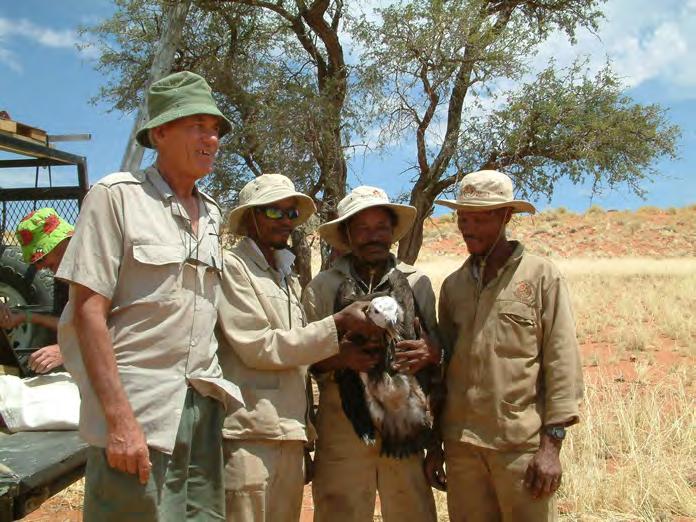
Hillen became warden and Keerweder was acquired, Abraham moved again. He still lives in the first staff house built at the homestead. Over the years, as each new warden came to the Reserve, Abraham remained a steady presence through them all.
Among his many stories, one of Abraham’s favourites is about the endless fascination people have with rocks. He recalls the countless times
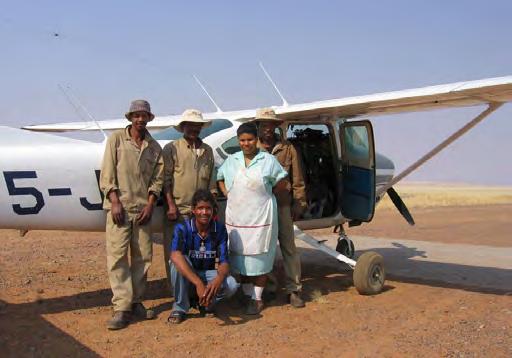
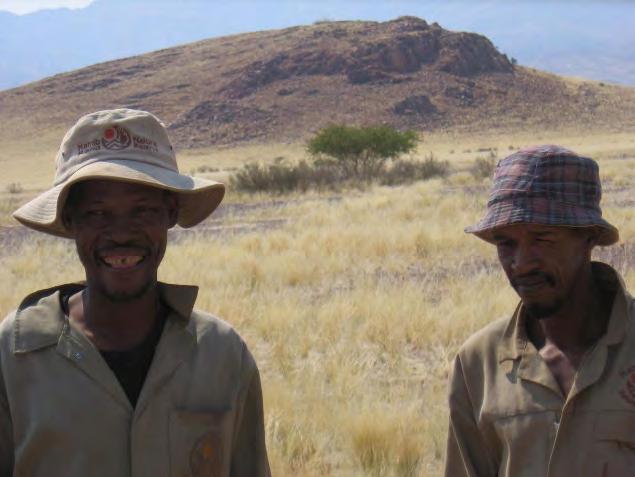

he was asked to move rocks in and out of the Keerweder garden, each new warden bringing their own vision and reshuffling the desert’s natural sculpture gallery. Through it all, Abraham kept track. He knows every rock, every tree, every corner of the Reserve, and the story behind each - who planted it, who moved it and who has walked past it.
In the heart of the desert, where survival is shaped by sun, wind and instinct, lives Abraham - a man whose knowledge of the land runs as deep as the roots of the camelthorn trees he reveres. Abraham doesn’t need a weather app, he simply lifts his gaze. “If the clouds aren’t over the Park by lunchtime,” he often says, “we won’t see rain.” It’s a kind of wisdom that can’t be taught, but only earned through a lifetime in this beautiful, dry and unforgiving landscape.
To the outsider, trees bleeding water might be a curiosity, but to Abraham, it’s a warning. “If the trees bleed, they die,” he says solemnly, referring to the slow, sap-like weeping of a tree under stress which is an omen of death in the desert. These are not merely observations, they are the signs and signals that guide his world, passed down in quiet conversations and long stares towards the horizon.
Recently, Abraham’s enduring bond with the land found a new expression through an unexpected project: the restoration of an old Ford vehicle. This relic, once a fixture behind the Keerweder homestead, had been a playground for Abrahams’ children before being moved to the scrapyard. When Andre embarked on reviving the vehicle, Abraham’s interest was immediately piqued. The prospect of breathing life into a piece of the farm’s history resonated deeply with him.
As Andre works meticulously to restore the Ford, Abraham remains a constant presence, assisting and sharing stories that bridge the past and present. For Abraham, this isn’t just a car, it’s a symbol of resilience and things built to endure. In the shared labour over rusted bolts and weathered steel, an old passion awakens — proof that even in the desert, new life can begin from the bones of the old.
In the convergence of Abraham’s desert wisdom and the revival of the old Ford, there’s a poignant narrative of renewal. It’s a story that underscores the value of heritage, the importance of preserving history and the profound connections that bind individuals to their environment.

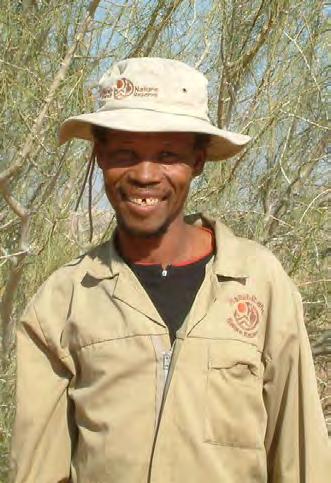


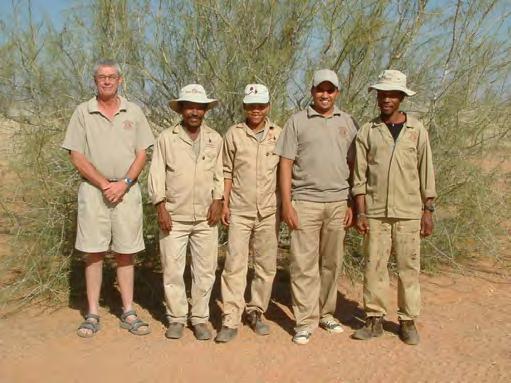

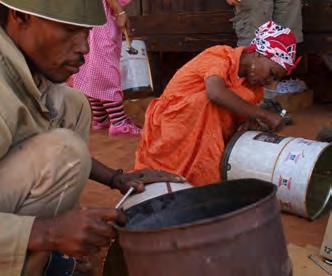

Now, as Abraham approaches retirement, the Reserve faces the bittersweet prospect of his departure. Though we wish for another 30 years with him, time reminds us to celebrate the decades we’ve already had. Abraham Tsaobeb is not just a long-serving worker, he is a living archive of NamibRand, a pioneer of the desert and a man whose legacy is etched into the land he loves.
Abraham was a very respectful, hardworking, trustworthy man who never complained and nearly always had a smile on his face. He was always keen to learn, but knew how to use pliers and wires to fix constantly leaking pipes.
— Kai Hillen (1994 – 1998)
During our time at NamibRand, Achim still led people through the Namib-Naukluft to the sea a few times. We realised that our staff, including Abraham, could not picture what the sea looked like so we decided to take them there. I will never forget their faces when we neared the sea. The surprise at seeing never-ending water was something they could almost not take it in. When we reached the coast, we stopped and got out. As we walked closer to the beach some huge waves hit the beach with a thunderous noise and all the staff, including Abraham, let out a scream and started running away. Eventually, they were able to venture into the shallow waters at low tide.
— Ursi Lensen (1999-2004) with Achim

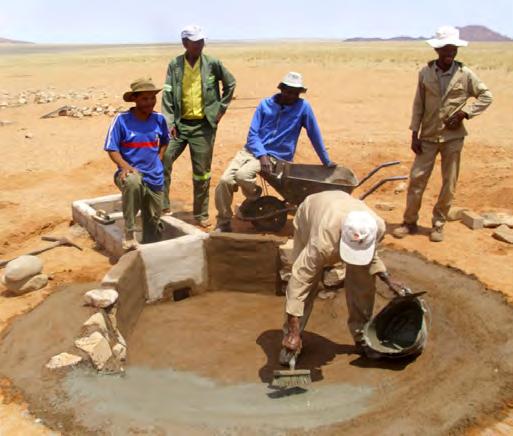
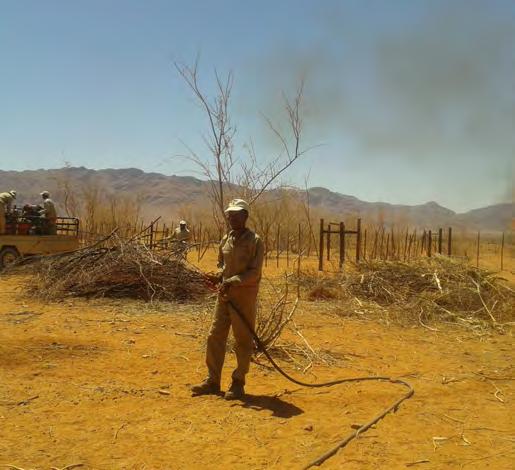
I worked with Abraham over 20 years ago, when we were still young and strong. I was on Aandstêr and so did not work with Abraham on a daily basis, but when we did work together or when I went to Keerwerder, Abraham was there, always friendly and helpful. He was instrumental in tracking the recently released giraffe, even over mountains that I thought mountain zebra would have a problem climbing. It was amazing to see the rocky gorge they climbed up and later down again with Abraham and other staff following them.
— Peter Bridgeford (2000 – 2004)
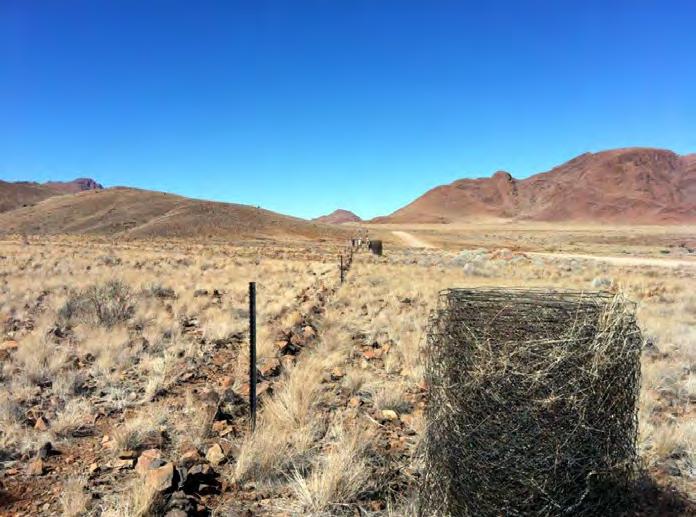
It has been a privilege to know and work with Abraham over the years that we have been associated with NamibRand Nature Reserve. He has shown himself to be a conscientious and loyal colleague, on whom one can always depend. Congratulations to Abraham on achieving this impressive 30year milestone and may there be many more years to come!
— Mike and Ann Scott (2009 – 2011)


In 2022, Abraham embarked for his last hike up to Losberg, he was the only one who knew the road, but they still got lost. He decided that he will not make the hike again and leave it to the younger generation to check on the Losberg radio repeater.
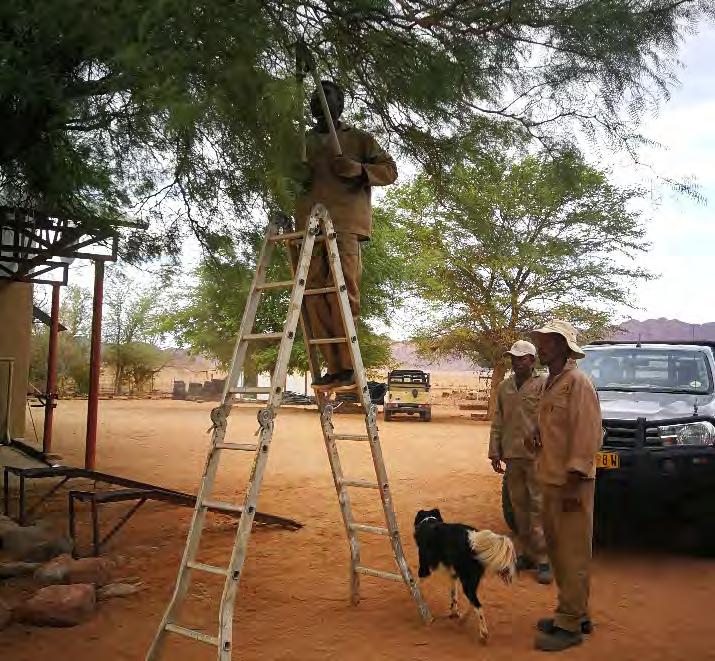
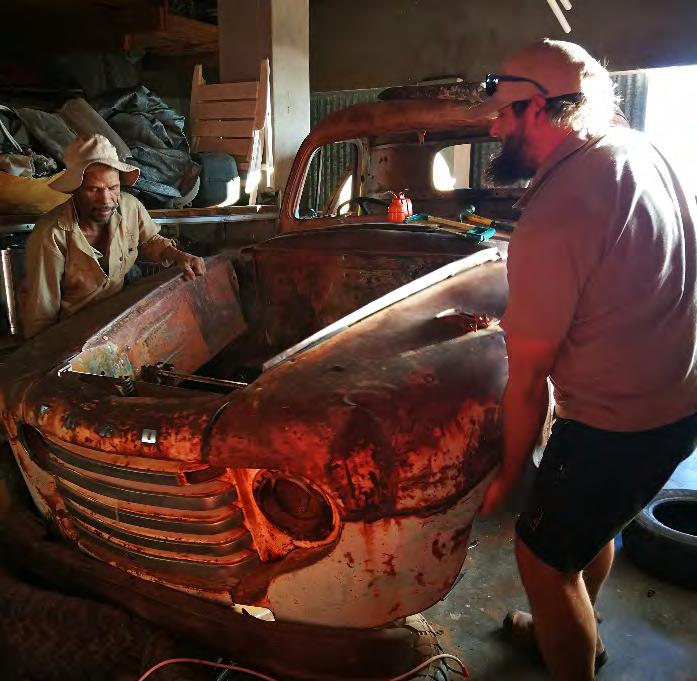
Congratulations to Abraham — 30 years in the Namib is truly commendable.
I started at NamibRand in June 2010 as a young WIL (Work Integrated Learning) student, and Abraham and the team took me under their wing. When I finished my WIL and NamibRand offered me a position as a Ranger I continued to learn from Abraham. He had a wealth of experience in managing the NRNR that I could only aspire to. This continued as I transitioned to Ranger and then Control Warden.
Abraham’s kind and friendly demeanour stands out as one of his greatest attributes and this did not change in all my six years working with him. I am blessed to have been part of his 30-year career at NRNR. Long may he continue to impart his knowledge, wisdom and kindness on everyone who has the pleasure of working with him.
— Quintin Hartung (2010 to 2016)
By Eberhardt Hofmann, translated by Jessica Steyn
The regular bare patches known as fairy circles, which occur in sparse and sometimes more lush grasslands, repeatedly draw researchers, scientists and tourists into the desert. Such was the case on February 27 and 28, 2025 for the “2nd International Fairy Circle Symposium” held atWolwedans on the private NamibRand Nature Reserve in southern Namibia. The first international symposium was held ten years earlier at the same arid location.
Seven ecologists and desert researchers attended the two-day symposium at NamibRand, which is at the center of their research activities. They flew in from Israel, South Africa and Germany. From Windhoek, they traveled another 500 km, mainly on gravel roads, to reach the picturesque venue of Wolwedans, where everything was prepared, including firstclass hospitality in the remote landscape.
Platform for Professional Contributions
With two exceptions, all participating researchers and ecologists had already been involved in fieldwork at NamibRand multiple times. At the symposium’s opening, NamibRand
CEO Nils Odendaal emphasized that the event aimed to provide a platform for professional contributions to explain the mysterious natural phenomenon of fairy circles. Although fairy circles have caught scientific attention since the 1970s, intensive research into their ecological details, changes and/ or consistency through wet and extremely dry periods has been ongoing for the past 40 years.
Most researchers and ecologists agree that fairy circles represent a coordinated system to utilize moisture from the desert’s rare rainfall. Grasses, insects — mainly termites — and other desert organisms use the circles to survive long dry periods, sometimes for years. However, if rain fails for too long, all visible life inside and around the circles apparently vanishes. Only the stubble of dried grass marks a prominent ring surrounding the bare patch. Then the miracle happens: a light or heavy rain after years of drought revives the fairy circle in exactly the same spot where the grass ring once flourished.
Up to this point, researchers have been largely in agreement
as to the reason for the circles. However, opinions differ sharply when it comes to the cause of the behind the surprisingly regular patterns of the bare patches and their characteristic grass rims on the arid plains.
Long-time fairy circle researcher Norbert Jürgens, who attended the first International Fairy Circle Symposium at Wolwedans, but was absent from the second one in 2025, proposed four more or less well-known hypotheses regarding possible factors or organisms responsible for the formation of fairy circles:
• Sand termites that attack grass roots in the bare patch;
• Self-organization of the grasses (vegetation self-organisation);
• Locally poisoned soil from dead Euphorbia bushes; and
• Geochemical gases and/or underground emissions.
“The debate about the origin of fairy circles is far from over. More experiments are needed,” says Jürgens, who supports the sand termite hypothesis.
At this latest symposium, participants presented results mainly supporting the hypotheses of self-organization of vegetation and the impact of dead Euphorbia.
Five of the seven speakers framed their presentations within the selforganization of vegetation theory, while one speaker elaborated on the impact of toxic substances from Euphorbia
All speakers agreed that fairy circles — whether in grassy areas or during droughts, faintly visible in barren sandy ground — are a natural phenomenon related to water management in desert and semi-desert environments. Within the circles, moisture remains available longer for grasses and insects as compared to outside areas with grass. Researcher Stephan Getzin from the University of Göttingen installed measuring devices in certain fairy circles at NamibRand to continuously monitor underground moisture and its fluctuations.
Jeremy Midgley from the University of Cape Town, in his concluding talk titled “Fairy Circles Remain Mysterious,” offered broad criticism of the two leading hypotheses: termite herbivory and vegetation self-organization (VSO). He questioned, for instance, why competing grasses perish only on the inner side of the fairy circle but not on the outer side in the matrix.
Regarding the termite hypothesis, Midgley pointed out that termites “move blindly through sandy tunnels,” are “polycalic” (made up of multiple interconnected colonies), and therefore incapable of creating perfect circles. He stressed that neither hypothesis had yet been fully backed by experimental evidence.
Stephan Getzin responded
to Midgley’s criticism, stating that the majority of “questions and objections have already been answered.” In his main presentation, Getzin outlined points leading to the conclusion that the fairy circle represents a universal adaptation to drought stress: “The circle is the most stable form for maximizing water access, hence the self-organised pattern arising from water stress.” He referenced 17 publications supporting this view.
Water Mobility in Sand
Michael Cramer from the University of Cape Town described experiments simulating water mobility in sandy soils. His measurements of vertical and horizontal water movement after rain, down to depths of 90 cm, aligned with the vegetation self-organisation hypothesis and the evenly spaced layout of fairy circles. “Water shapes landscapes in the narrow rainfall belt of 60 to 140 millimeters,” he stated, also addressing the roles of evaporation and condensation.
Resilience of Arid Ecosystems
Ehud Meron from Ben-Gurion University used the grasses of the “fascinating Namibian fairy circles” to illustrate plants’ multidimensional adaptability beyond their inherited traits. This enhances individual plant survival and leads to the characteristic regular vegetation patterns seen in arid regions — a collective response to water stress, allowing more water access for some plants while others die off.
Hezi Yizhaq, also from Ben-Gurion University, discussed the different shapes and patterns of fairy circles on the Giribes Plains north of the Hoanib River in Kaokoland. His latest recordings from March
2024 showed that circles there are more oval than round — up to 32 meters long and only 7 meters wide — and are aligned along barely visible contour and drainage lines. His measurements indicated that conductivity and permeability within the fairy circles were four times higher than outside in the matrix.
Marion Meyer from the University of Pretoria supports the hypothesis that dead Euphorbia bushes on sandy soils in the 50150 mm rainfall zone have given rise to fairy circles. Soil analyses of spots where euphorbias had died showed that their sticky, toxic latex remains on the sand grains, making them hydrophobic (water-repellent) and antimicrobial. Meyer also reported that the population of Euphorbia along the edge of the Namib had declined between 6787% and attributed this to climate change, as midday temperatures had risen by 2°C between 1950 and today. He added that neither he nor his team ever observed a fairy circle with a germinating Euphorbia
Tour guides and staff from NamibRand and surrounding tourism companies attended the symposium with great interest. At the closing discussion, one asked: “How are we supposed to explain fairy circles to tourists in a few words?” The question remained unanswered. Another participant concluded: “Hopefully, the mystery will never be solved — otherwise, there would be no more visitors.”
The symposium was sponsored by Natural Selection, the Wolwedans Foundation and the NamibRand Nature Reserve.

Fairy Circle Researchers - front row from left to right: Ehud Meron (Ben-Gurion University of the Negev, Israel), Michael Cramer and Jeremy Midgley (University of Cape Town) and Shachar Feder (Ben-Gurion University). Back row from left: Stephan Getzin (University of Göttingen), Marion Meyer (University of Pretoria) and Hezi Yizhaq (Ben-Gurion University).

Fairy Circle Excursion - Stephan Getzin from the University of Göttingen explains detailed moisture measurements at a very dry fairy circle in late February 2025. After years of drought, this area at NamibRand received rain again.
Fairy circles are round, bare patches with a diameter of about six meters in grasslands along the edge of the Namib Desert, in areas receiving 50 to 150 mm of annual rainfall. The rim consists of perennial grasses, which generally grow larger and stronger than the same grasses outside the circle.
Distribution:
Fairy circles occur over a stretch of 1,785 km from the Richtersveld in Namaqualand, with a few interruptions, along the edge of the Namib Desert to southern Angola.
Frequency:
In the Great Sand Sea of shifting dunes where average rainfall is only about 25 mm annually (e.g., in the Sperrgebiet or Tsau //Khaeb), fairy circles are absent, but they appear on flat soils between dunes. Researcher and author Norbert Jürgens recorded 1,850 locations of fairy circles across the 1,785 km stretch, divided into 14 geographic areas.
Age:
Estimates of the age of individual fairy circles vary widely between researchers. Norbert Jürgens estimates hundreds of years while Walter Tschinkel suggests around 60 years. Circles can completely vanish after several extremely dry years but reappear at the same location following good rainfall.
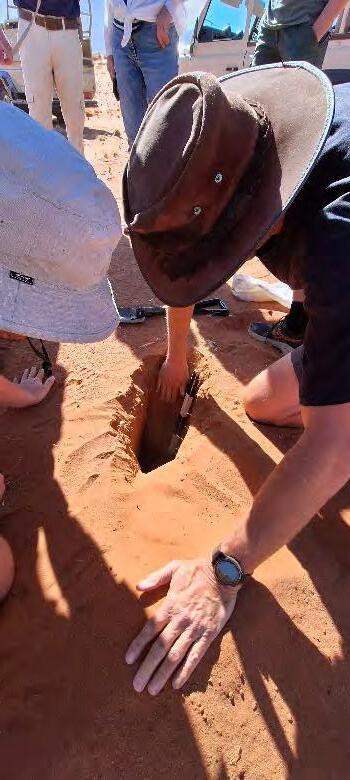
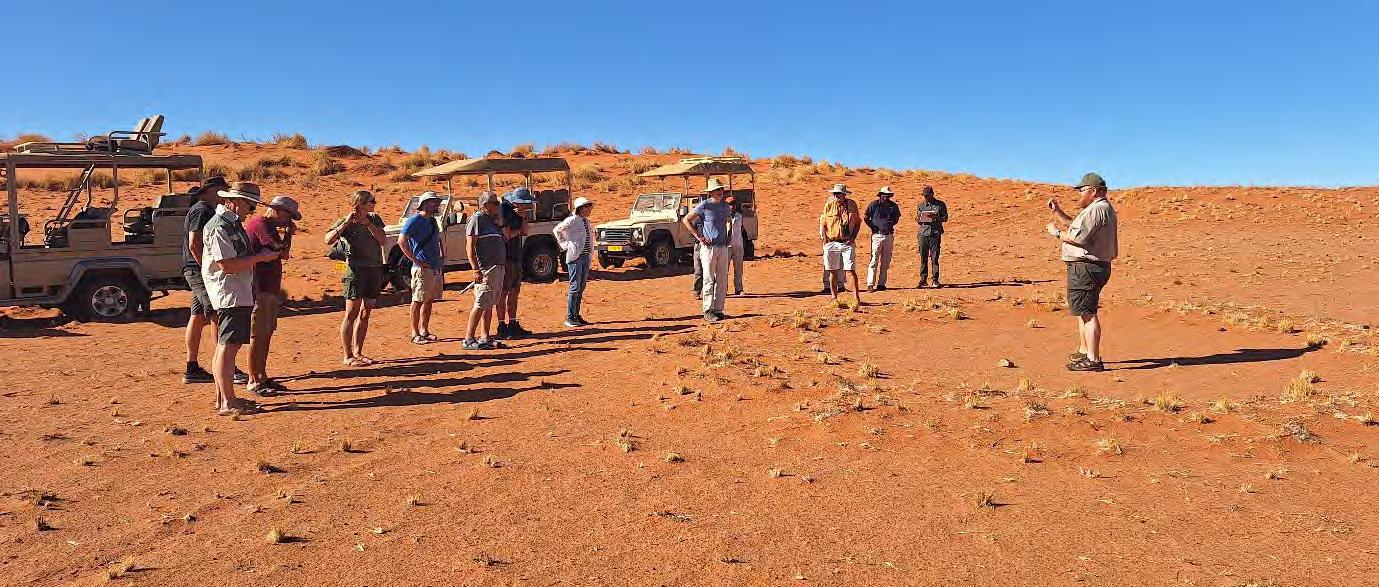
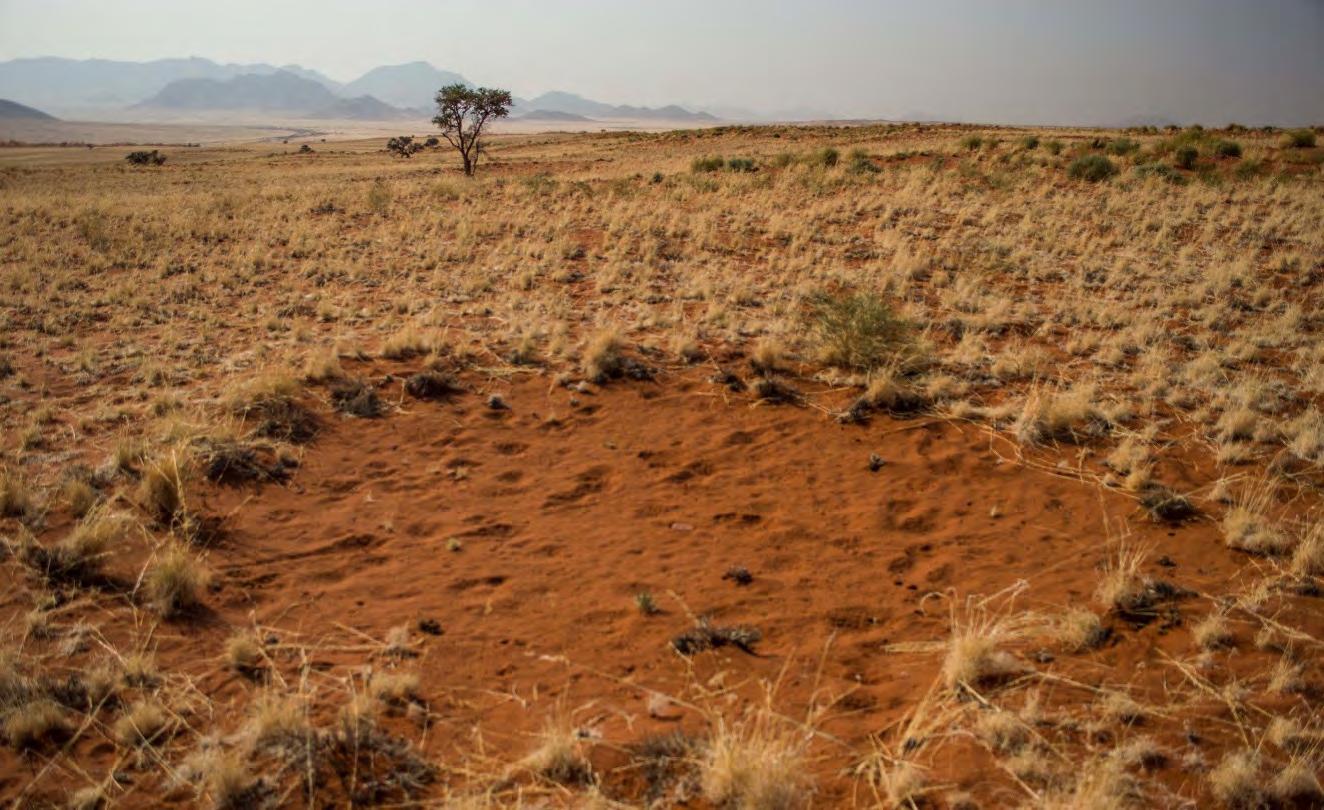
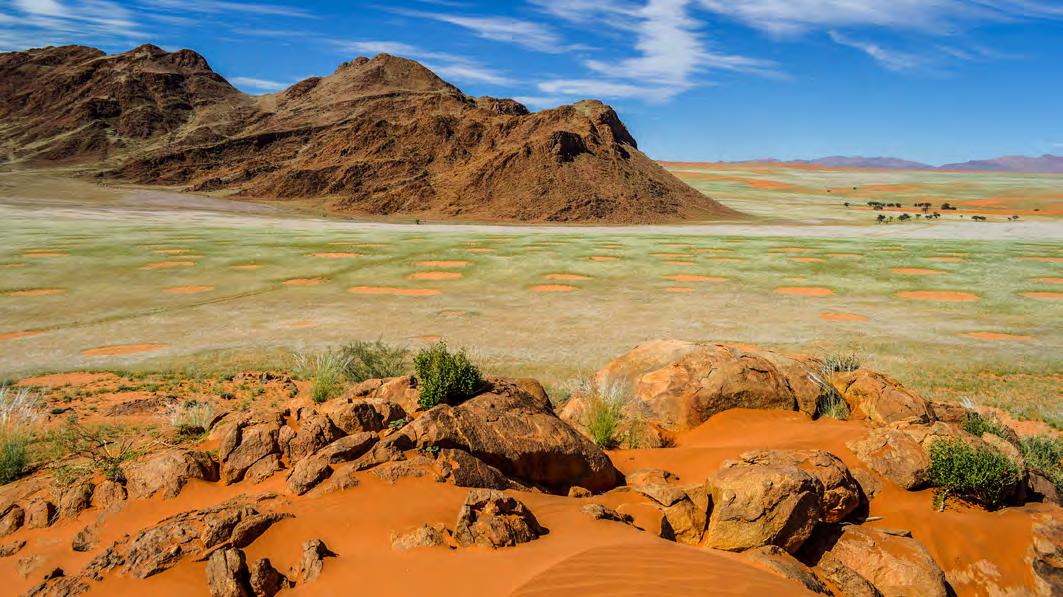
By Mariette Mukamana
Namib Sky Community Trust, established in July 2012, is dedicated to enhancing lives in the Sossusvlei area. It provides free primary education and school meals at Namib Sky Community School and offers a sewing project to create income opportunities for locals. The school serves 50 children, from pre-primary age three to Grade 4 and promotes sustainable development and empowerment.
This year, we’re thrilled to celebrate some milestones which enhance our educational setting:
Our upper primary hybrid learning centre is now operational, combining traditional and digital education with interactive screens and computers. This setup enhances resources beyond in-person
instruction. Our first Grade 4 students have started with the system and we aim to expand with Grade 5 in 2026.
We’re also excited about our new art room, where children can explore their creativity through a broad art curriculum. This addition highlights our commitment to a well-rounded education nurturing both academic and artistic skills.
Overall, Namib Sky Community Project is progressing well and fostering a vibrant learning environment. We’re excited about these positive achievements and anticipate the growth and successes of our students and community in the future.



By Andreas Brückner
The NamibRand Family
Hideout Campsites offer more deluxe amenities after a recent upgrade. Following

last year’s heavy winds, the Hideout decided to replicate the very successful wind protection roller blinds at Campsite Jupiter
at both Campsites Orion and Venus as well.
These roller blinds guard



against the elements from all directions and are lowered or rolled up with a simple rope and pully system by the campers themselves.
In addition, new braai places were constructed at all campsites to replace the old bulky ones.
The Hideout opted for a round design with face-brick stones and special heat-resistant fire stones. For grilling, clever tripod stands are available which are very practical and work like a charm.
In order to offer some wind protection for the braai area, several beach windbreakers were tested and the best was selected for use at the campsites.
Although a few upgrades have been made, the main attraction of the hugely popular campsites remains the fact that there is no one around. The next campsite is far away, out of sight and hearing from anything other than pure nature.
While upgrades to the campsites were in progress, the House also received a new braai place.
The Hideout remains true to our motto ….
only you and the desert.

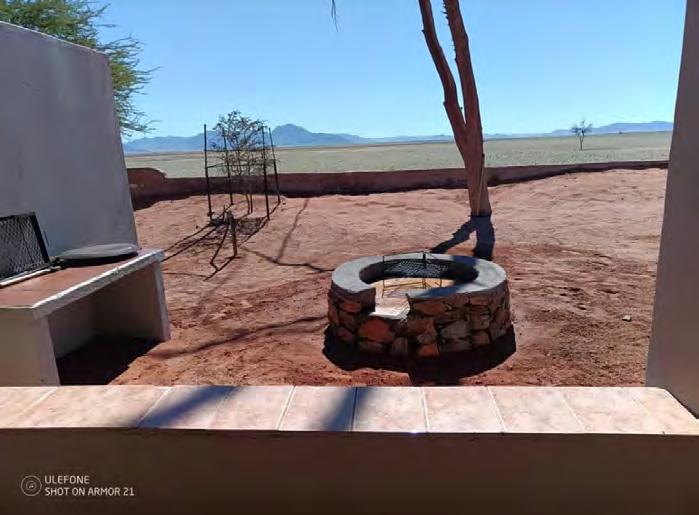
NamibRand hosted three Nature Conservation Students from the Namibia University for Science and Technology during the first half of the year. These insights from each student showcase their experiences.
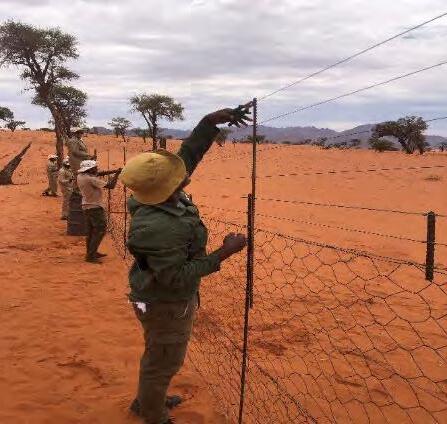
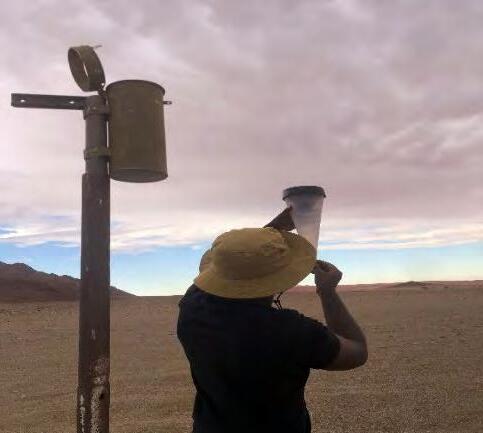
My experience at the NamibRand Nature Reserve (NRNR) has been one of the most stunning periods in my life. During my time at NRNR as an intern, I was actively involved in a wide range of conservation and maintenance activities including monitoring rainfall, repairing fences, assisting with wildlife management and conducting research. I also contributed to daily operation activities such as water pipe repairs, vehicle inspections and the renovation of office spaces.
The ground was barren when we arrived and I was not sure if I could complete my study project, which focuses on grass biomass. However, with rain that soon followed, all that changed. Overnight, spaces turned green and grass sprouted everywhere in profusion. Life returned to the desert. As someone interested in nature, seeing this transformation was very emotional.

Although my time is coming to an end, I feel very fortunate to have an opportunity to learn from this ecosystem, to reside in the desert and to watch it prosper. This is such a unique place and this experience has increased my enthusiasm for my future in natural resources management.


I had the unique opportunity to engage in hands-on conservation work in one of the most breathtaking desert landscapes in Namibia at the Namibrand Nature Reserve. This internship offered a blend of field work, research and maintenance work, including daily tasks such as fencing, removing pipes and caretaking of infrastructure.
As the sun dipped below the distant Naukluft
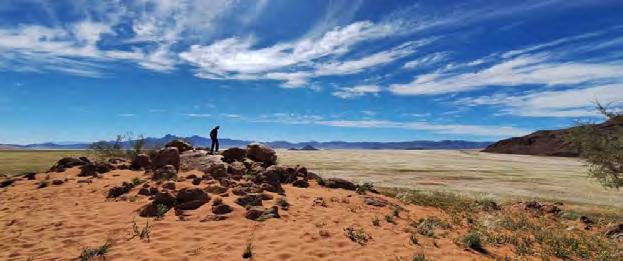
I have been at NamibRand Nature Reserve for several months, and honestly, it’s been an interesting experience. The wide-open areas, the peace, the wildlife and the fact that each day can be so different have all increased my appreciation of nature. One minute it is clear and sunny, and the next moment there’s a surprise rain shower or clouds rolling over the mountains. It’s beautiful in a raw, peaceful way.
I conducted a research project that looks at the !nara plant and how different environmental factors affect its growth and where it’s found. Fieldwork has its ups and downs - some days are super productive, while other days you feel like the sun is out to finish you. Although its challenging, I learned a lot and that’s what matters.
I was also fortunate enough to take part in the dark sky readings, which was such a special moment. Seeing the
Mountains, the vast Namib desert transformed into a canvas of fiery colour, hues of deep orange and glowing gold spilled across the horizon, and a gentle breeze whispered through the green grasses of the Reserve.
My project was to study the abundance of vegetation in the northern part of Namibrand, which included grasses, herbs and trees.

stars so clearly, with no city lights around, is something I won’t forget. It really reminded me how small we are in such a big universe.
The NamibRand team was very helpful and friendly during my internship. They made it easy to settle in and understand how things work on the Reserve. Overall, I’m grateful for this opportunity. I’ve already learned so much, and I’m looking forward to sharing my experiences.
By Festus Awene, Environmental Educator
Every participant who has visited NaDEET and used its facilities, specifically the waterwise washrooms, has had a chance to interact with the beautiful art murals on the rear walls as they fetch their hot water to fill the bucket showers. Unfortunately, these murals were getting old after withstanding the
harsh desert weather for more than ten years and they needed an update.
In 2024, NaDEET received prize money from the Legal Assistant Centre as part of the Environmental Investment Fund Award for their educational comic “Troubled Waters: Coastal
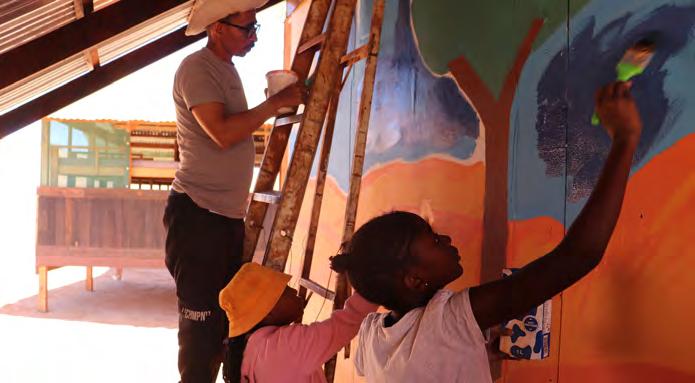
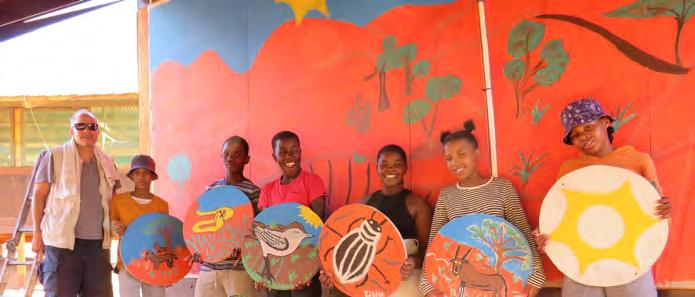
protection, communities and constitutional commitments”, written by Hans-Christian Mahnke. This prize money was awarded for art-related work and NaDEET decided to donate it towards an art programme. This also happened to meet our need to renovate the water-wise washroom murals. NaDEET invited learners who are passionate about the arts from schools within the Hardap Region that have not had a chance to be part of our programme this year.
The implementation of the programme was done with the assistance of 19 learners from three schools, with transport provided by the Ministry of Education, Arts and Culture, the Hardap Regional Office and HansChristian Mahnke. The learners who took part in the programme were from Vooruitsig Primary School in Rehoboth, D.D. Guibeb Primary School in Mariental and Kalkrand Primary School in Kalkrand. These learners were specifically chosen through the regional office.
The four-day programme was centred around art as a way of raising environmental awareness. At the beginning of the programme learners were divided into three groups. The groups were also assigned to complete specific mural designs for the water wise washroom
walls. The theme of the murals was the local environment and landscape of the NamibRand Nature Reserve. One mural displays the beautiful night sky, the second displays a daytime dune landscape with different diurnal animals and the third mural displays a night time dune landscape with nocturnal animals. These themes were chosen because they are what the participants at NaDEET experience and interact with during their programme.
Much of the time during the programme was allocated to work on the murals. Learning activities such as a biodiversity dune walk and sustainability practices such as solar cooking, waste management and water conservation were also incorporated within this special programme.
Festus Awene, an environmental educator at NaDEET Centre, reflected that learners were shy at the beginning of the programme since they were from different schools, but highlighted that they completed all the murals and enjoyed the painting process. Festus was assisted by Albertine Kandjala, an intern and Centre Assistant at the Centre.
One of the teachers, when asked what they enjoyed most about the programme responded that “I have enjoyed the painting part. I even discovered that I have a talent for painting.”
One learner reflected that “my favourite activity was painting and drawing and drawing. I love it so much.”
If you are visiting NaDEET Centre next time, take a minute to view with these beautiful murals that depict the stunning landscape, biodiversity and night sky of the NamibRand Nature Reserve.
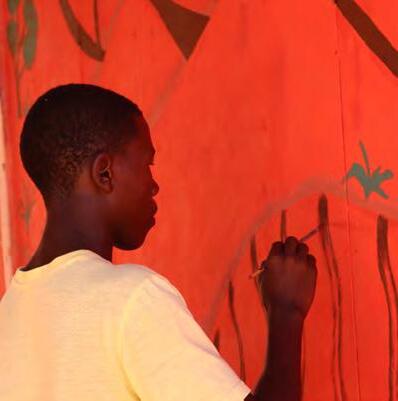


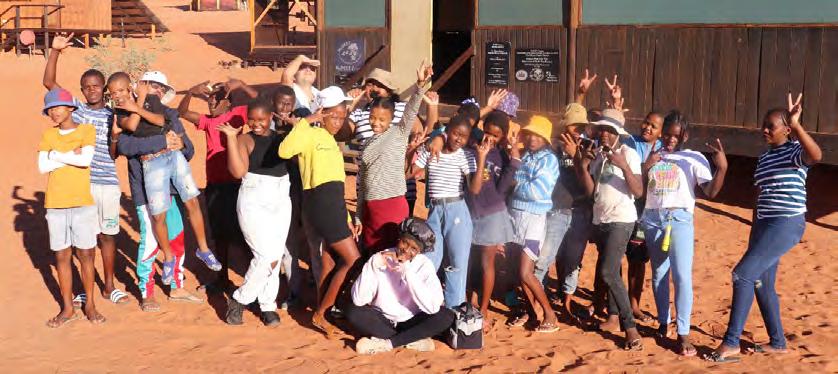

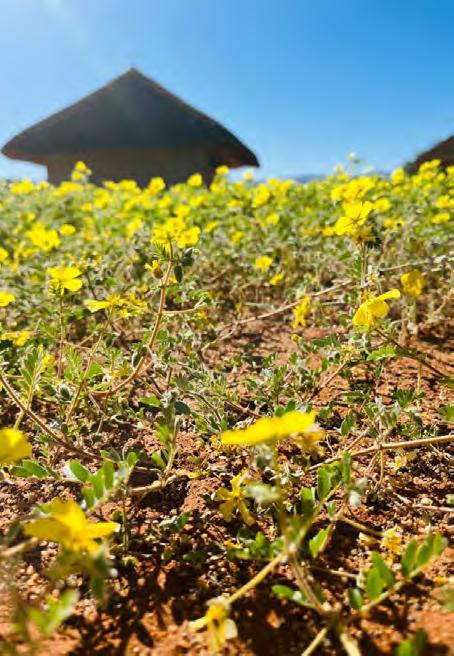
A close up of the vegetation
By Sarah Mabuta
Kwessie Dunes Lodge received a very good amount of rain this season, which was a very pleasant surprise for the camp. After it rained, the guides who have been here since the camp opened started talking about how beautiful it would look soon, once the grass grew and the flowers bloomed.
Having never experienced the camp after good rains, I got very curious and excited. I can honestly say I was not prepared enough for the experience. I went on leave for two weeks and arrived back to camp late at night so I didn’t see anything until morning.
My room faces the east and the first thing I saw that morning was a field of yellow flowers in the beautiful morning light. I stood there and just smiled, enjoying the gorgeous view.
This reaction only increased when I saw the rest of the camp and was able to take a drive all the way to the airstrip and back. I saw zebra for the first time, a whole herd of them, together with springbok, ostriches and more oryx than I had ever seen before. It was stunning, and we now have even more birds in the area, so the first sound I hear every morning is the songs of birds. I love it every time.
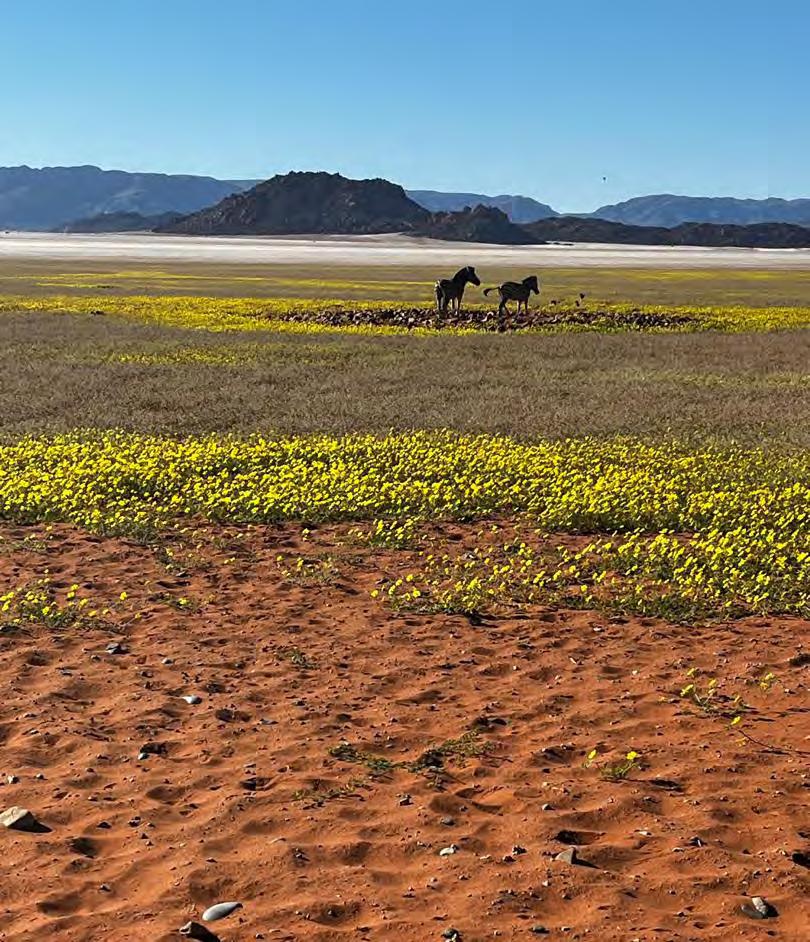

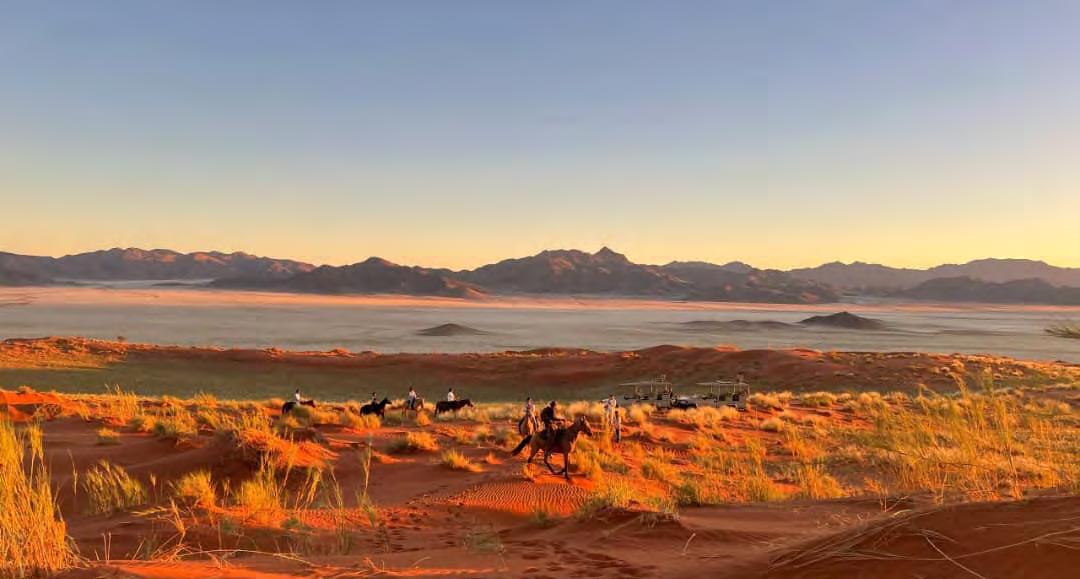
Horseback adventures amidst NamibRand’s stunning landscape
By Annely Ickua
The Namib Desert with its vast undulating dunes and expansive horizons, offers an unparalleled backdrop for equestrian exploration. In 2025, the desert’s allure was heightened by the rejuvenating rains that breathed new life into its arid expanse, painting the landscape with unexpected bursts of greenery and attracting a plethora of wildlife. For those seeking an intimate connection with this transformed terrain, horseback riding presents an immersive and soulful journey.
Nestled within the heart of the NamibRand Nature Reserve, Wolwedans stands as a beacon of sustainable luxury and authentic desert experiences. Renowned for its commitment to conservation and community development, Wolwedans offers guests the unique opportunity to traverse the desert’s majestic landscapes on horseback.
Whether you’re a seasoned rider or a novice, Wolwedans caters to all skill levels. Guided rides meander through golden grasslands, ascend towering dunes and skirt ancient camelthorn trees. Riders have the chance to view oryx, springbok and other desert-adapted wildlife in their natural
habitat. The rains this season further enriched these excursions, with blooming flora adding splashes of color to the sandy canvas.
It’s essential to note that due to the desert’s intense summer heat, horse riding activities do not take place between December and March. Guests are therefore encouraged to plan their equestrian adventures during the cooler months and to book in advance to ensure availability.
Horseback riding in the Namib is more than a recreational activity; it’s a journey into the soul of the desert. The rhythmic cadence of hooves on sand, the whispering winds and the vast open skies converge to create an experience that resonates deeply with the spirit. As the desert bloomed anew in 2025, there is no better time to saddle up and explore its wonders.
For those seeking to embark on this unparalleled adventure, Wolwedans and its collection of lodges within the NamibRand Nature Reserve stand ready to guide you through the desert’s ever-evolving tapestry.
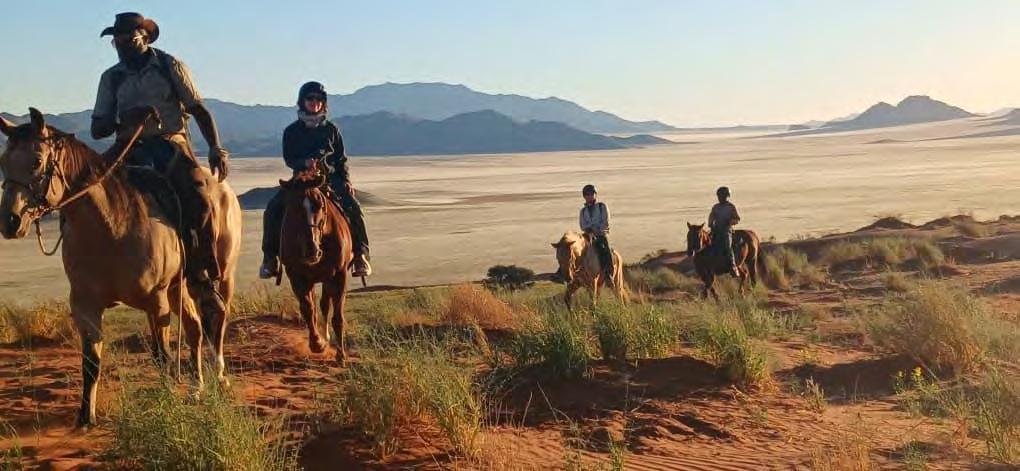

Departing from the stables

Specialist guides are ready to take you on your adventure
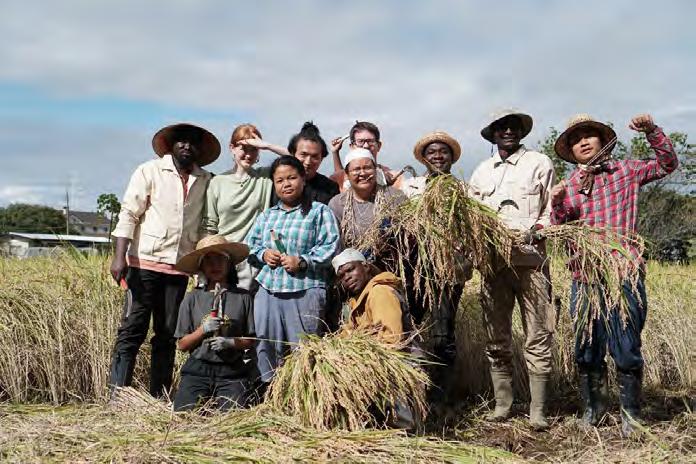

By Jonas Ndeuludila
Ihad the honour of spending a significant portion of 2024 in Japan, where I participated in the Rural Leaders Training Program at the Asian Rural Institute (ARI) in Nasushiobara. This program focuses on leadership, sustainable agriculture and community development. Over nine months, from March to December, the group trained as grassroots leaders from rural communities. Our group comprised twenty participants from thirteen countries, including six from Africa. I was proud to be the first representative from Namibia. It was a privilege to represent not only NaDEET, but also my entire
country. There was much work to be done.
This training program, based on servant leadership, aims to empower leaders by equipping them with essential skills. Participants explored rural leadership with an understanding of the unique challenges facing rural communities. The curriculum emphasises participatory learning, encouraging community involvement in decisionmaking. It also covers nonviolent communication, fosters empathetic dialogue and teaches coaching strategies to inspire others. Additionally, topics like
peace, reconciliation and the cultural contexts of religion and rural life were discussed to enhance our understanding of rural leadership. The training also focused on innovative approaches such as farming with disabilities to promoting community participation in agriculture. Although leadership training might sound familiar, there was so much to learn. It was a different approach and I obtained a much deeper theoretical understanding and ability to implement my learning, because at ARI theory meets practice.
Sustainable agriculture encompasses a broad range
of concepts and through my exploration of this field, I gained valuable skills and experience. I engaged with topics such as organic farming, crop and vegetable production, livestock management, rice cultivation, poultry management, the dangers of chemical farming, agroforestry and much more.
In the realm of community development, I deepened my understanding of the vital connections between nutrition and development, as well as the intricate relationship between the environment and societal progress. I explored important topics like gender issues and the importance of localisation, along with training in ecology and natural resources. I learned about the pressing challenges posed by climate change, while gaining insight into the inspiring Japanese organic farming movement. Throughout this journey, I became acutely aware of the struggles faced by marginalised communities and the urgent need for inclusive solutions that uplift every voice.
It was a profound experience, beginning in the classroom and extending to various life management activities. The Food Life Initiative involved practical work centred around food self-sufficiency and community engagement. The highlight for me was transplanting rice in the rice paddies. Maintaining your balance and focus is crucial; otherwise, you risk falling into the mud. It was an entirely new experience for me. This experience allowed me to connect with different people from around the world while also appreciating the beauty of Japan — its stunning landscapes, diverse vegetation and paddy
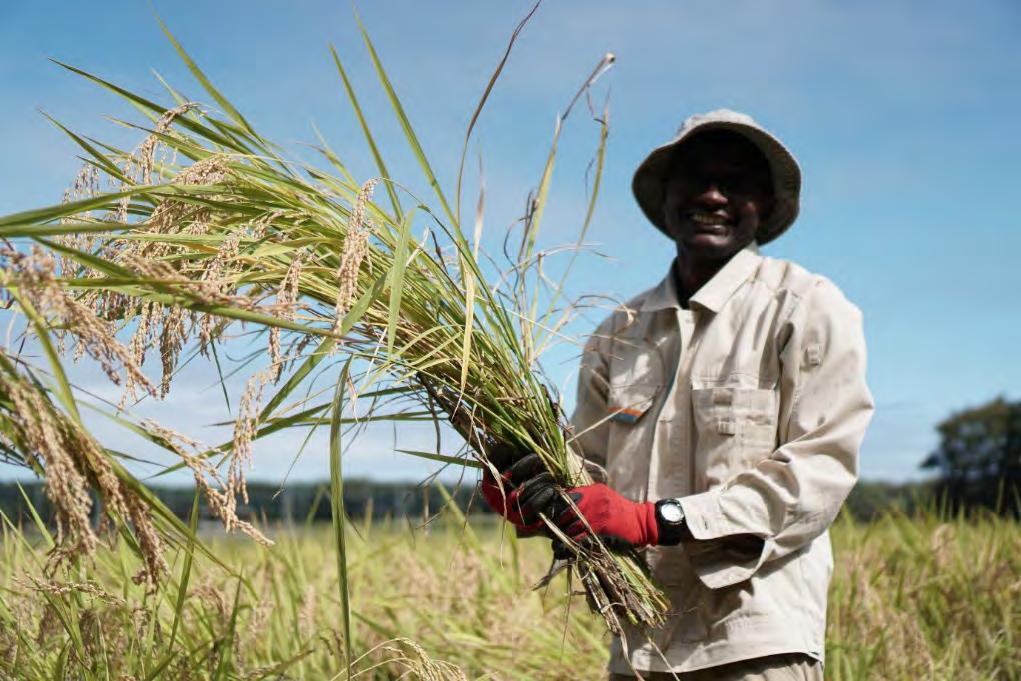
fields adorning the countryside. Through excursions throughout Japan I learned a lot about the rich Japanese culture, food, history and language, although I am still a beginner.
I had the privilege of living in a rich and diverse culture, surrounded by varied religious backgrounds and expertise. I met ecologists, farmers, professors
and specialists in various fields. Residing in a developed country has profoundly influenced my perspective, allowing me to adopt a more holistic approach to understanding issues and identifying opportunities for my own country and community.
I have become particularly curious about how technology has transformed the recycling
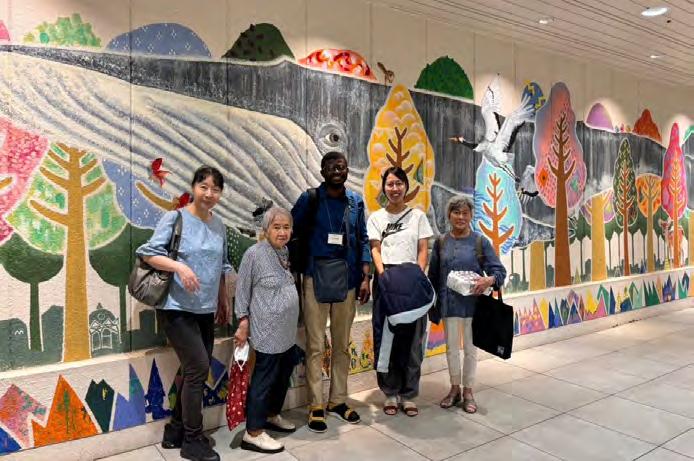
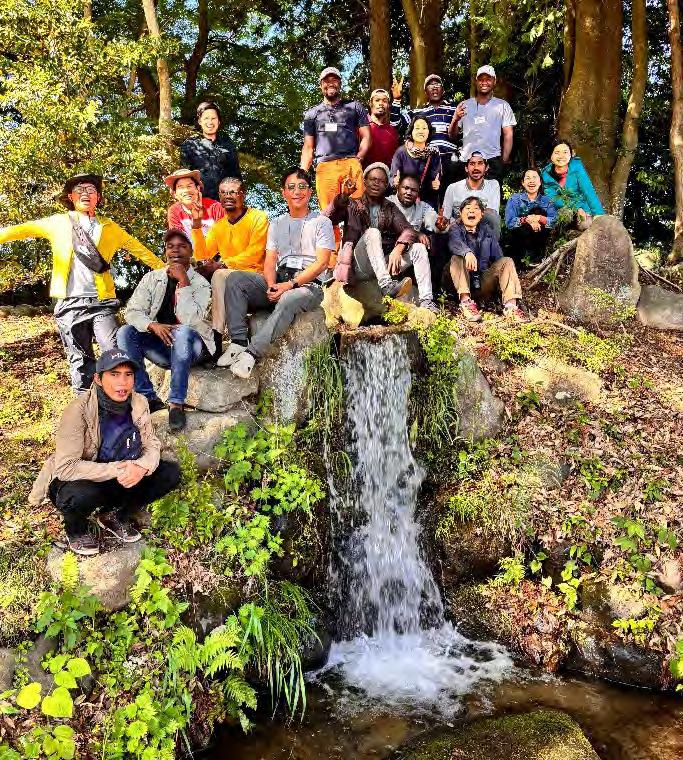

Experiencing snow
industry and its efficiency. Although I have been involved in recycling efforts, my understanding of what occurs at main recycling facilities was minimal. I was fascinated to discover that some recycling centres manage to recycle approximately 90% of some materials, including building materials such as concrete blocks and the iron sheets from roofs.
Additionally, I am interested in organic farming and aim to use my new knowledge to promote sustainability within our NaDEET garden.
In Japan, I travelled by various modes of transportation and each offers its own unique experience. Whether it’s travelling by train, aeroplane, cruise ship, bicycle or bus, each journey has its charm. For instance, on a bus journey I passed through a tunnel that stretches for about two kilometres, with lush vegetation covering the top. It was truly something new and interesting for me.
Conservation is deeply ingrained in me; it’s an irreplaceable part of my being. I’ve had the incredible opportunity to hike mountains adorned with active volcanoes and clouds. The various seasons in Japan stood out vividly. Spring captivates with cherry blossoms, while autumn showcases the trees in all their distinctive beauty. Winter brings its own thrill with my baptism in snow and even snowboarding adventures. I have a profound love for rain, which graces the land almost every month, contributing to the country’s lush greenery. Not only is the environment pristine and tranquil, but the people are also warm and welcoming with exceptional hospitality.
Training in Practice at NaDEET
Upon returning to my work at NaDEET, I started slowly implementing the lessons I learned. For instance, using locally collected resources more efficiently. For instance. We are using new solutions for sustainably using cooked compost. In February, our team began focusing on enriching the soil before planting any seeds, with the aim of fostering vibrant, living soil.

Fall leaf viewing
During my sustainable agriculture training at ARI, I frequently heard the phrases “what you need is around you” and “local resources.” These ideas prompted me to think creatively about the plethora of resources at Die Duine that can enhance our garden. Leveraging local resources is an effective way to achieve sustainability and maximise what we have — a lesson adopted from Nature.
It is truly remarkable to witness the garden’s progress so far in rehabilitating the soil, enhancing vegetable production and fostering healthier plants. We have successfully achieved a 100% recycling rate of organic waste through our gardening initiatives. Our composting methods have been improved by effectively utilising all available local resources, including human resources, indigenous knowledge and the experience gained through staff development. Materials such as brown waste from cleaning, kitchen compost (both cooked and uncooked),
bones, eggshells and packaging from food deliveries, which were once discarded, have now become valuable resources.
As time goes on, more of my learning will be implemented and shared. The training was complex and it takes time to process the learning into practice at home.
I want to express my heartfelt gratitude to Umamatsu for their generous sponsorship, which made my participation possible. A special thank you goes to the ARI team, who opened the doors to Japan for me and my fellow participants, creating a nurturing environment where we could learn and grow together. I’m genuinely thankful to all my incredible colleagues for sharing this meaningful journey with me — your support has made all the difference. Lastly, a profound thank you to NaDEET for being my steadfast support throughout this experience and helping to turn everything into reality.
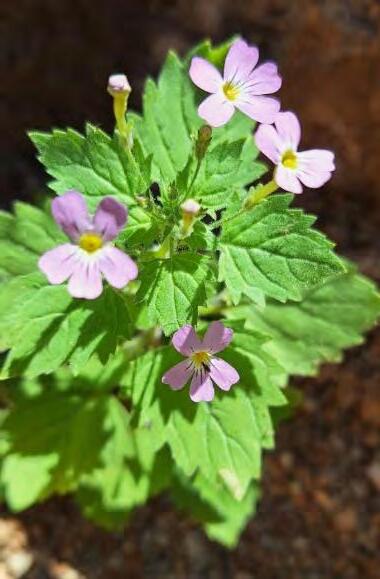


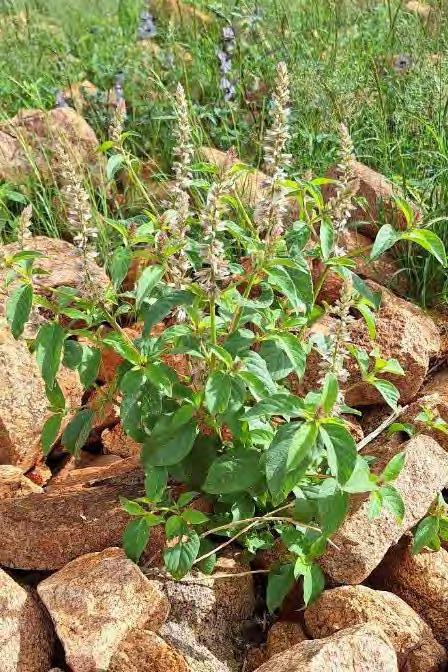
By Jessica Steyn
Thanks to the generous rains this season, the NamibRand Nature Reserve experienced a burst of colour and life. Plants that had long been dormant sprang back to life, transforming the landscape into a vibrant tapestry of blooms. It was an incredible sight - a true celebration of nature’s resilience.
Over several weeks, our team made trips into the veld to photograph, collect and identify the many plants that emerged across the Reserve. Each species we identified helps build a clearer picture of the incredible biodiversity we are so privileged to protect. When new or previously unrecorded species are discovered, they are
added to the NamibRand species list, helping us expand our understanding of the flora that calls this place home.
We didn’t just capture the beauty of these plants in full bloom.
By recording them at different stages of growth, we aim to create a comprehensive visual record. This is crucial to improve identification and monitoring of plant development over time. All this valuable information is
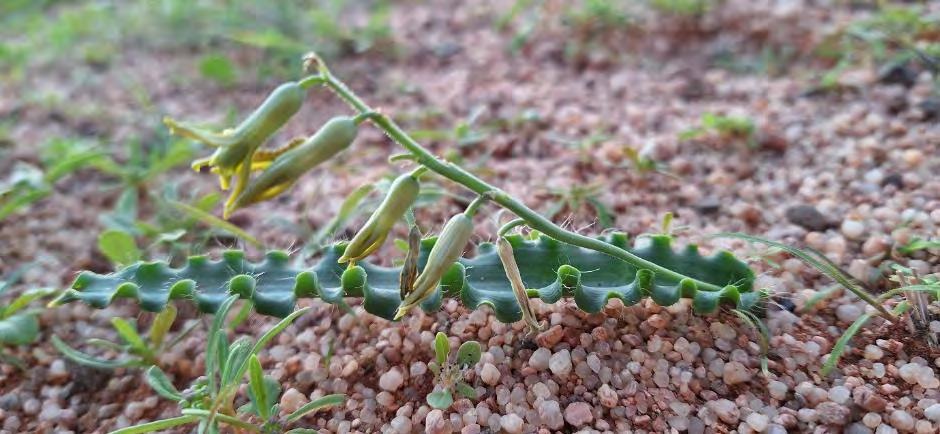
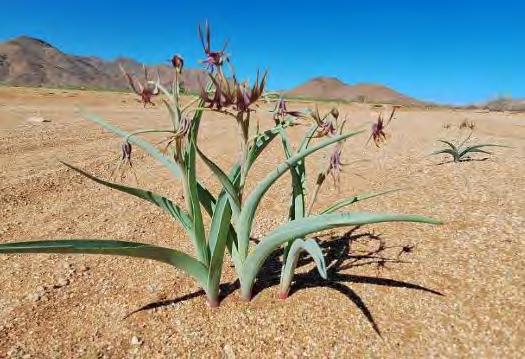


regularly updated on our website for everyone to explore.
In addition, we are working on updating the NamibRand Herbarium — a definitive reference collection that is available for use by researchers, students and nature enthusiasts. This project ensures that our knowledge of the Reserve’s plant life is both recorded and shared widely.
All collected and photographed plants are also submitted to the Namibian EIS Atlas, a national database that supports citizen science efforts. It’s a collaborative project, and we encourage everyone with a passion for nature to get involved in documenting Namibia’s incredible biodiversity.
Nature truly showed off this rainy season — we’re thrilled to have been able to capture and share every moment of it!
Across these pages are some of the plants collected and photographed by Jessica Steyn:
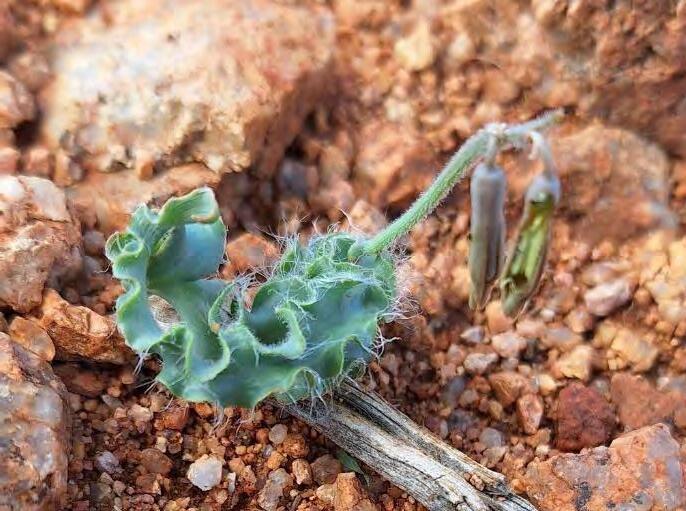

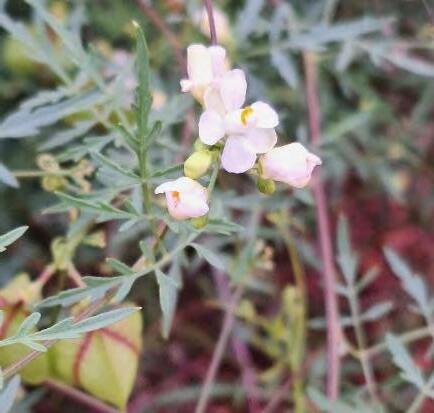
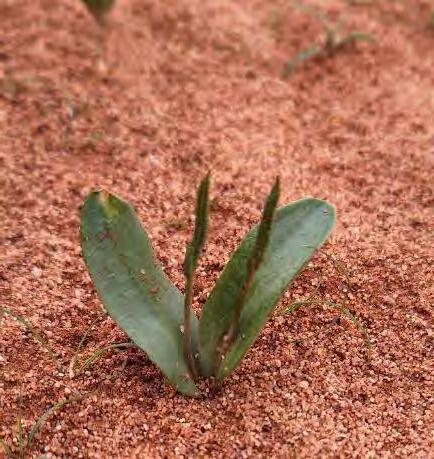
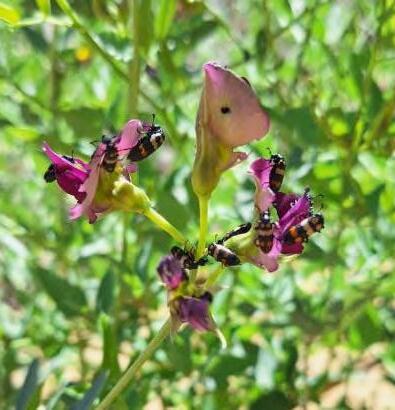


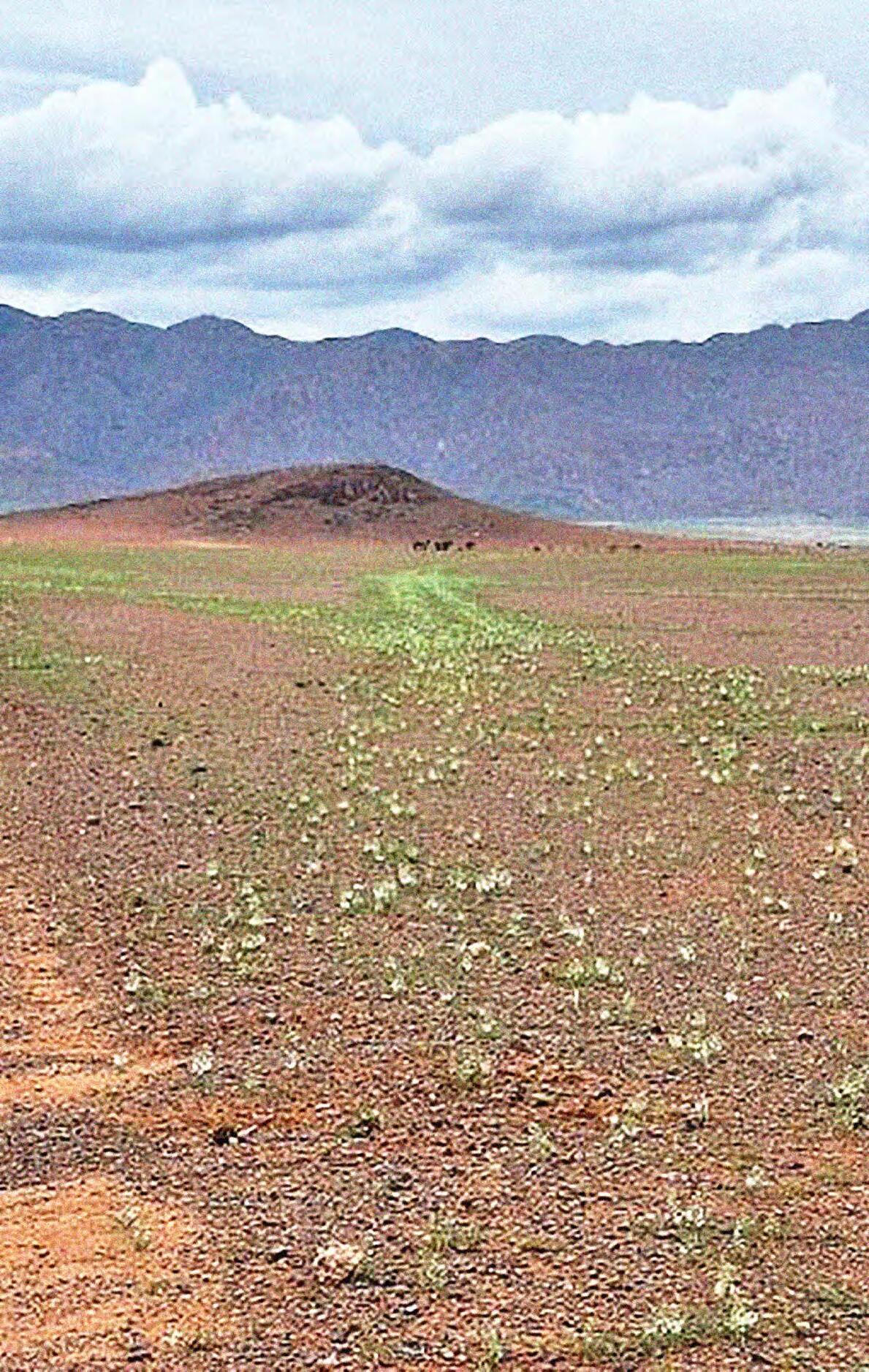


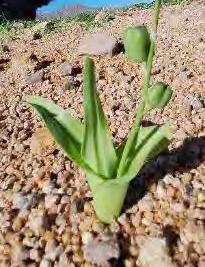

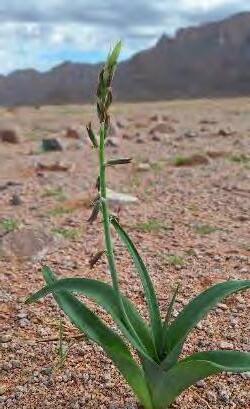


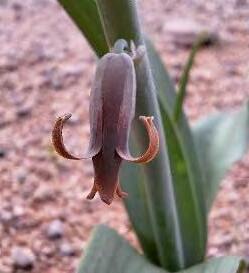

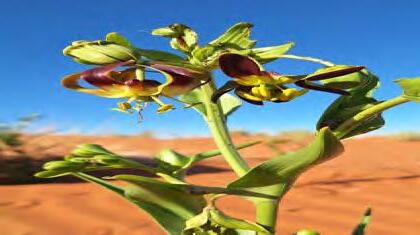

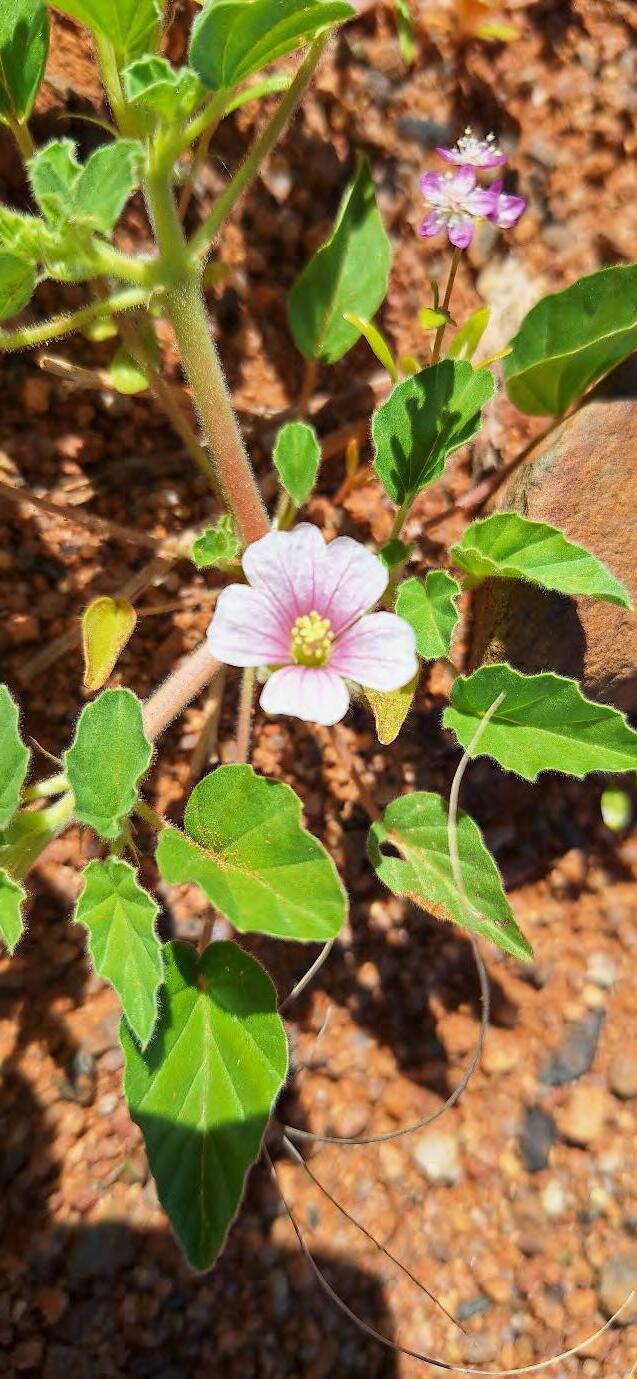
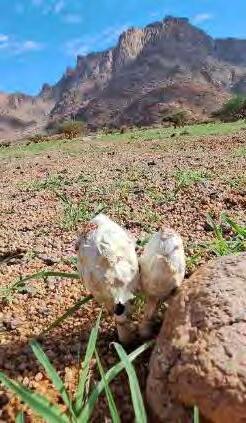



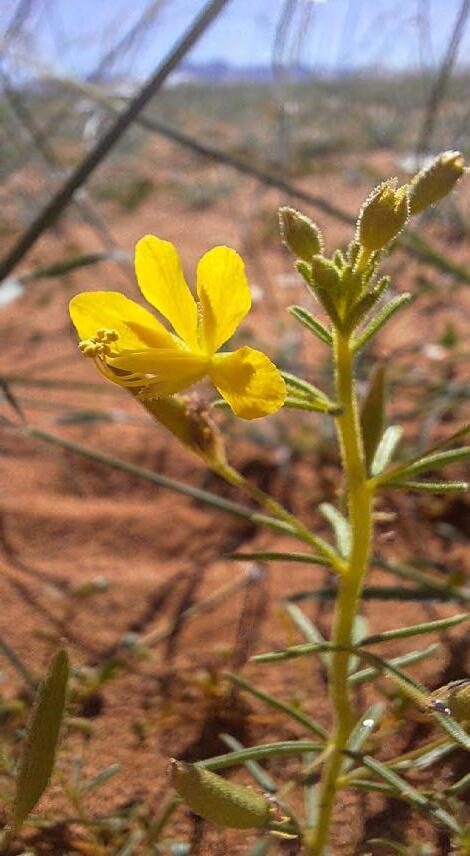



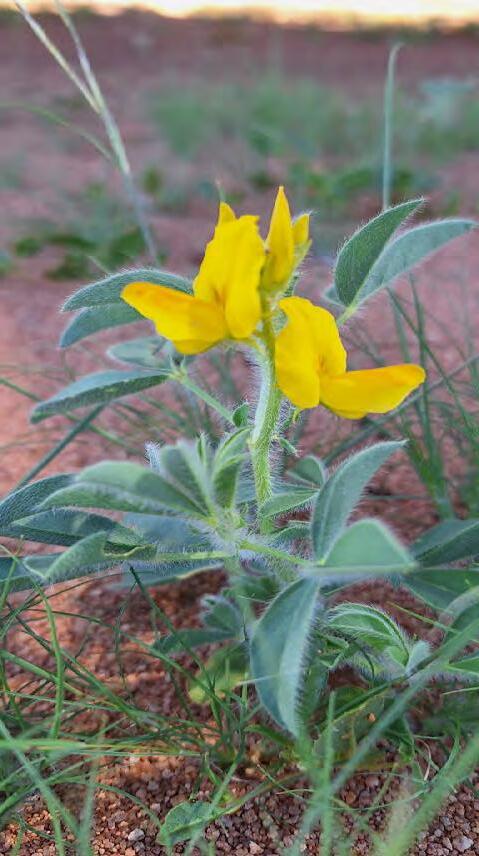
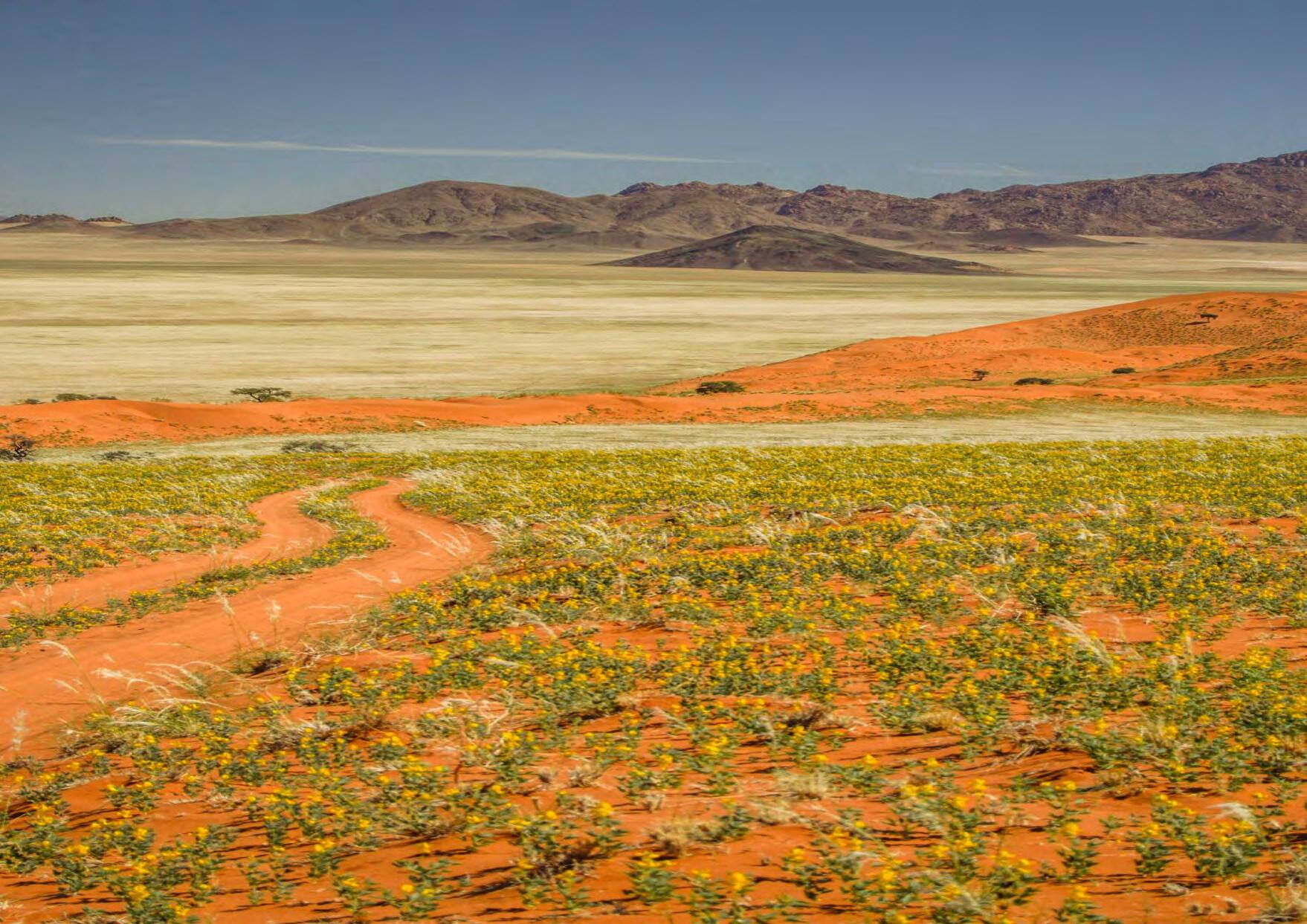
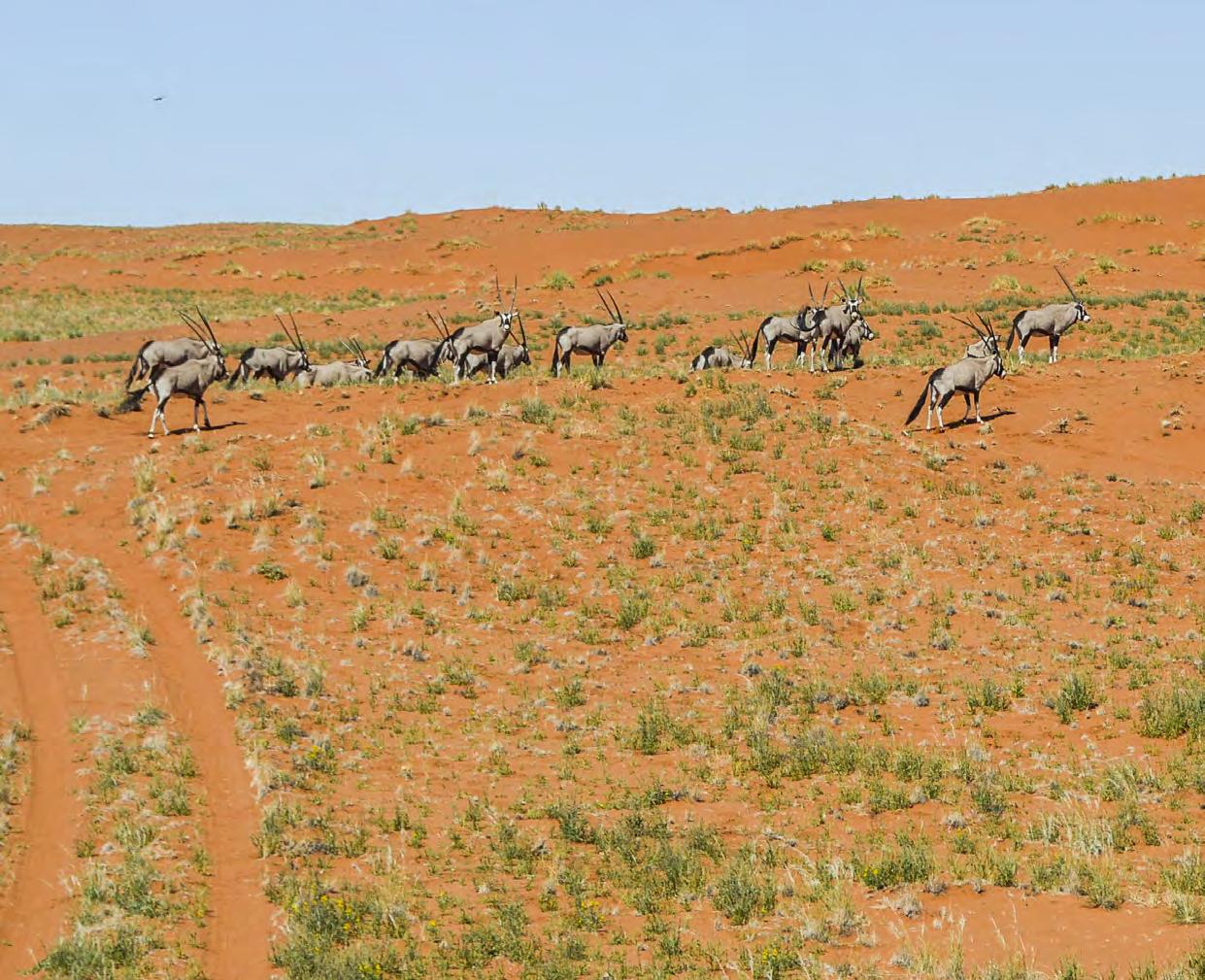
Group of oryx in the dunes.
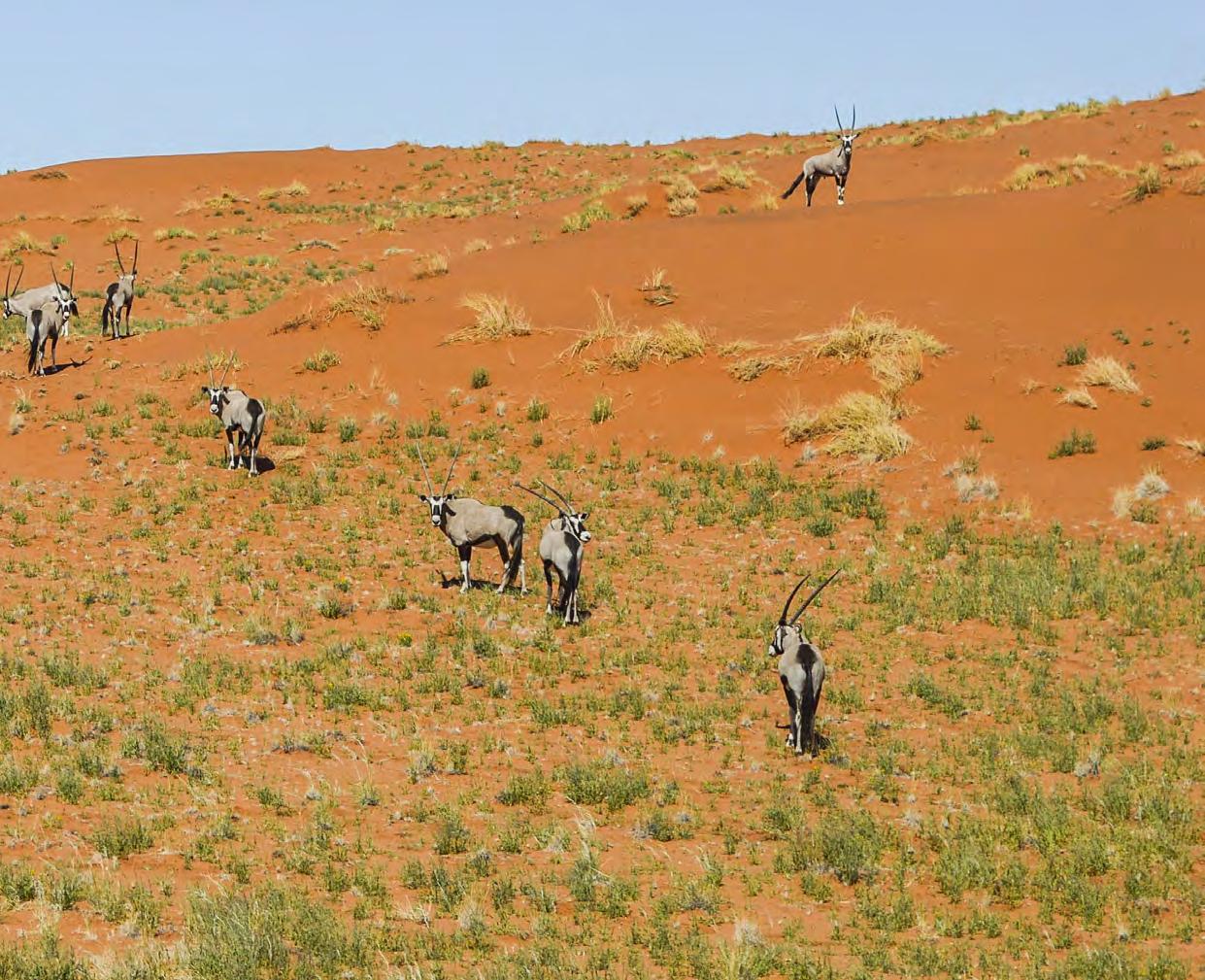
Lush green vegetation between the rocks

The editors would like to thank all the contributors to this edition of the Barking Gecko. Many thanks to Vicky Human for her support and layout skills.
This newsletter is for our readers, friends and colleagues of NamibRand. We welcome any ideas, input and feedback you may have.
KINDLY NOTE:
Photographs are under copyright and may not be reused without the permission of the photographer.
Editors: Jessica Steyn, Nature Conservation Warden, & Danica Shaw
Reserve Office
PO Box 131
Maltahöhe, Namibia
Phone: +264-63-683 026
Email: research@namibrand.org
Head Office:
76 - 68 Frans Indongo Streeet PO Box 40707 Windhoek, Namibia
Phone: +264-61-224 882
Email: info@namibrand.org
Website: www.namibrand.org

If you wish to subscribe to the Barking Gecko, please contact the editor at the above address. Note that previous issues of this newsletter are available on the NamibRand website.